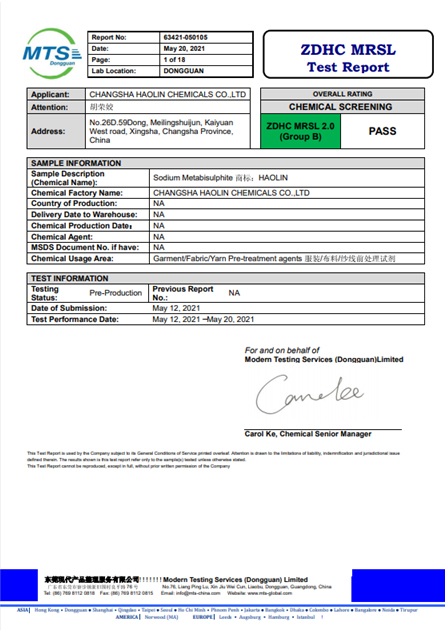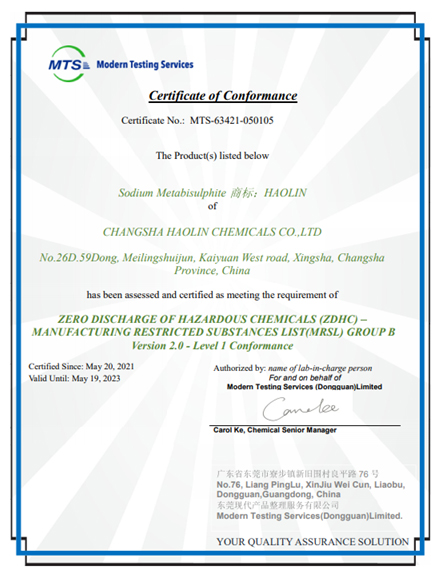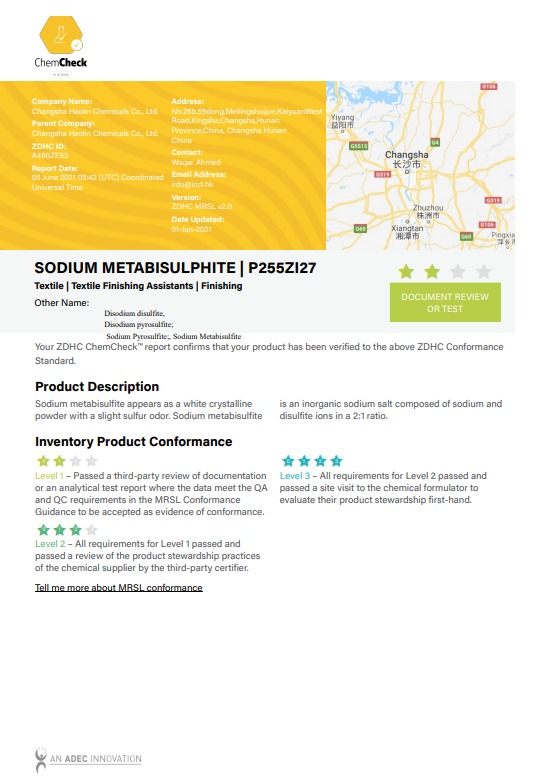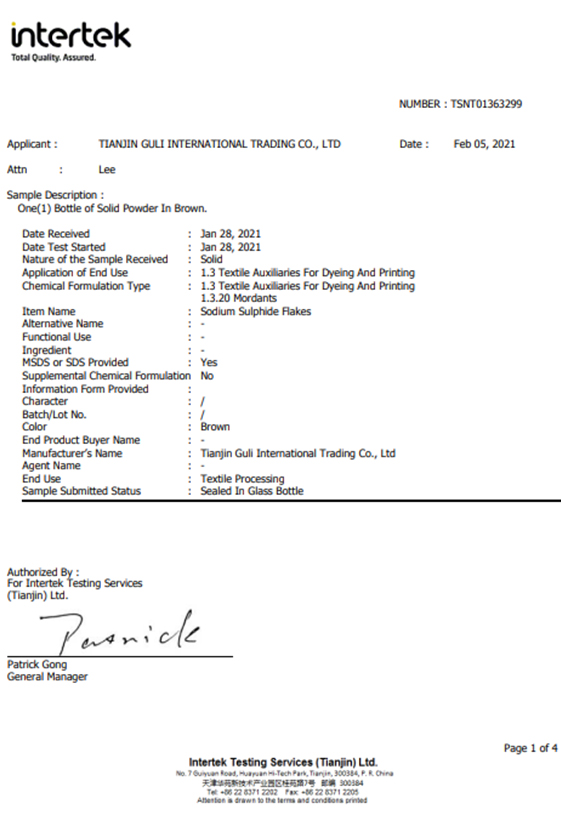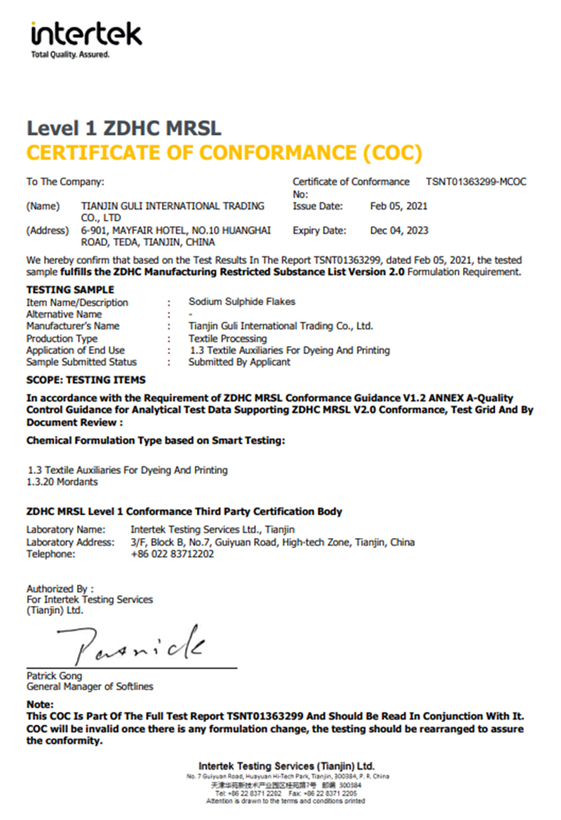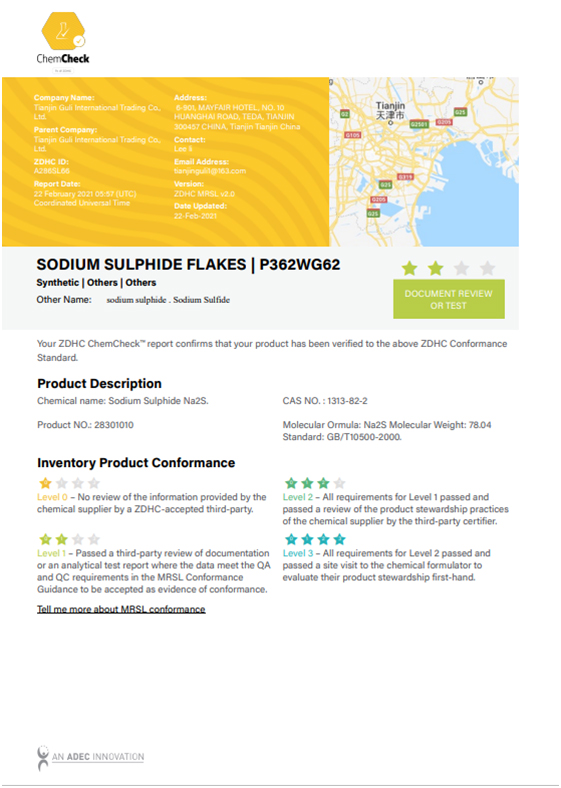Sulphur Black BR Powder
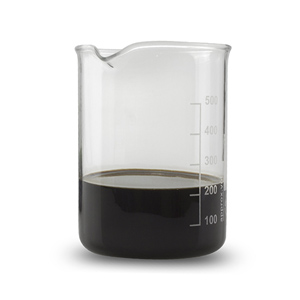
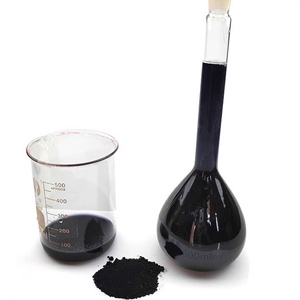
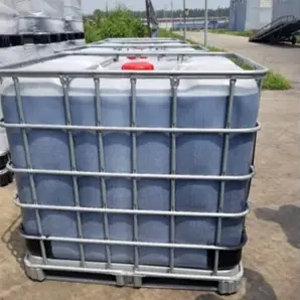
| Colour sample | Products | C.I. NO. | Fastness | |||||
| Light | Soap Washing | Hot Pressing | ||||||
| bleed | staining | |||||||
| Sulphur Black BR120% | BLACK 1 | 5 | 3-4 | 3 | 4 | |||
| Sulphur Black BR150% | BLACK 1 | 5 | 3-4 | 3 | 4 | |||
| Sulphur Black BR180% | BLACK 1 | 5 | 3-4 | 3 | 4 | |||
| Sulphur Black BR200% | BLACK 1 | 5 | 3-4 | 3 | 4 | |||
| Sulphur Black BR220% | BLACK 1 | 5 | 3-4 | 3 | 4 | |||
| Sulphur Black BR240% | BLACK 1 | 5 | 3-4 | 3 | 4 | |||
Greenish tone
| Colour sample | Products | C.I. NO. | Fastness | |||||
| Light | Soap Washing | Hot Pressing | ||||||
| bleed | staining | |||||||
| Sulphur Black BN120% | BLACK 1 | 5 | 3-4 | 3 | 4 | |||
| Sulphur Black BN150% | BLACK 1 | 5 | 3-4 | 3 | 4 | |||
| Sulphur Black BN180% | BLACK 1 | 5 | 3-4 | 3 | 4 | |||
| Sulphur Black BN200% | BLACK 1 | 5 | 3-4 | 3 | 4 | |||
| Sulphur Black BN220% | BLACK 1 | 5 | 3-4 | 3 | 4 | |||
| Sulphur Black BN240% | BLACK 1 | 5 | 3-4 | 3 | 4 | |||
Sulphur Black BR Liquid

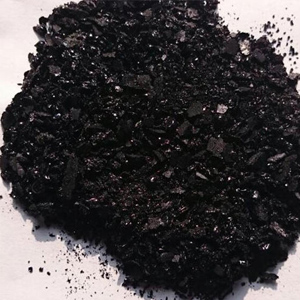
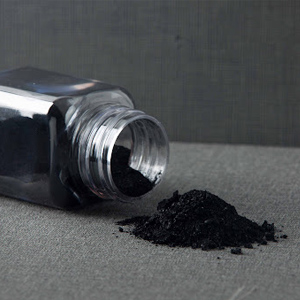
| Colour sample | Products | C.I. NO. | Fastness | |||||
| Light | Soap Washing | Hot Pressing | ||||||
| bleed | >staining | |||||||
| LIQUID SULPHUR BLACK BR 100% (GREENISH REDISH TONE) | BLACK 1 | 5 | 3-4 | 3 | 4 | |||
| LIQUID SULPHUR BLACK BB 100% (GREENISH TONE) | BLACK 1 | 5 | 3-4 | 3 | 4 | |||
| LIQUID SULPHUR BLACK RR 100% (REDISH TONE) | BLACK 1 | 5 | 3-4 | 3 | 4 | |||
GLUCOSE BASE
| Colour sample | Products | C.I. NO. | Fastness | |||||
| Light | Soap Washing | Hot Pressing | ||||||
| bleed | staining | |||||||
| LIQUID SULPHUR BLACK CMR 100% (GREENSIH TONE) | BLACK 1 | 5 | 3-4 | 3 | 4 | |||
Dyeing for paper
| Colour sample | Products | C.I. NO. | Fastness | |||||
| Light | Soap Washing | Hot Pressing | ||||||
| bleed | staining | |||||||
| LIQUID SULPHUR BLACK 10GT 100% (DYEING FOR PAPER) | BLACK 1 | 5 | 3-4 | 3 | 4 | |||
 Advantage to Liquid Sulphur Dyes
Advantage to Liquid Sulphur Dyes Introduction to Liquid Sulphur Black
Introduction to Liquid Sulphur BlackSulphur Color Dyes

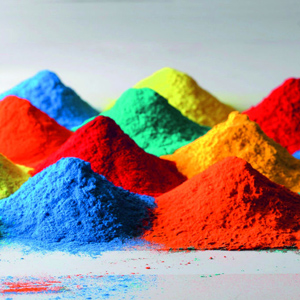

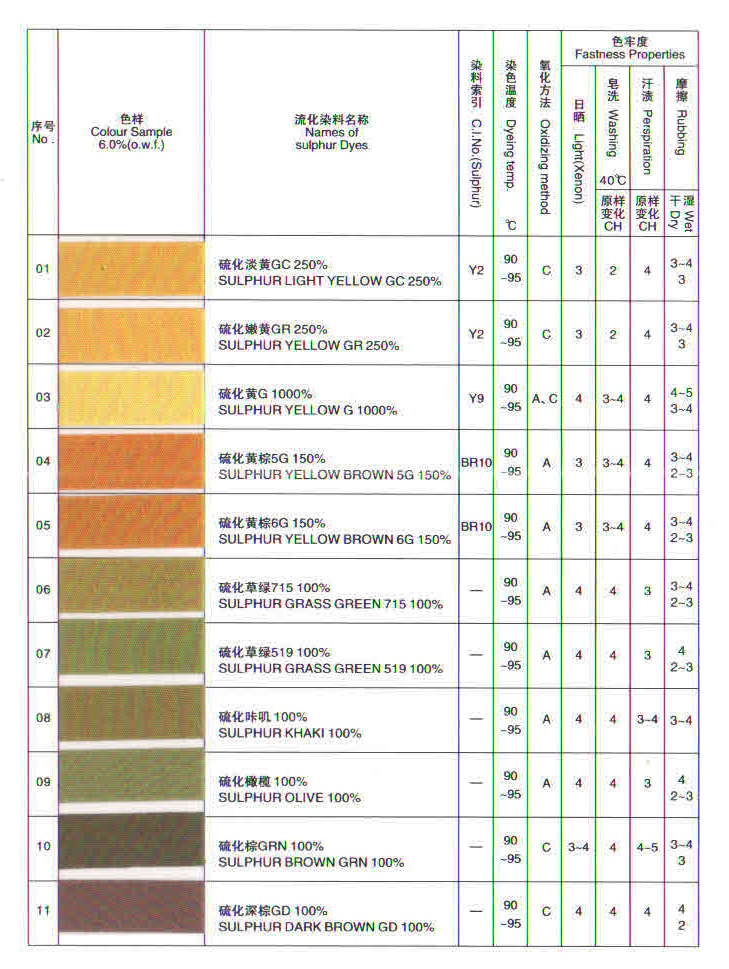

Hydroindigo 90
CAS NUMBER |
7555-14-6 |
EN NUMBER |
231-890-0 |
STRUCTURE |
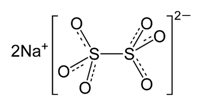 |
CERTIFICATE |
ISO9001 : IDO14001: ISO18001 |
PACKAGE |
50 KG / 100 KG / 200 KG PACKE IN IRON DRUMS |
USAGE |
Requires reducting agent during the dyeing process. is able to minimize damage risk in indigo dyeing and finally guarantee the Denim Coloration quality efficiently. |

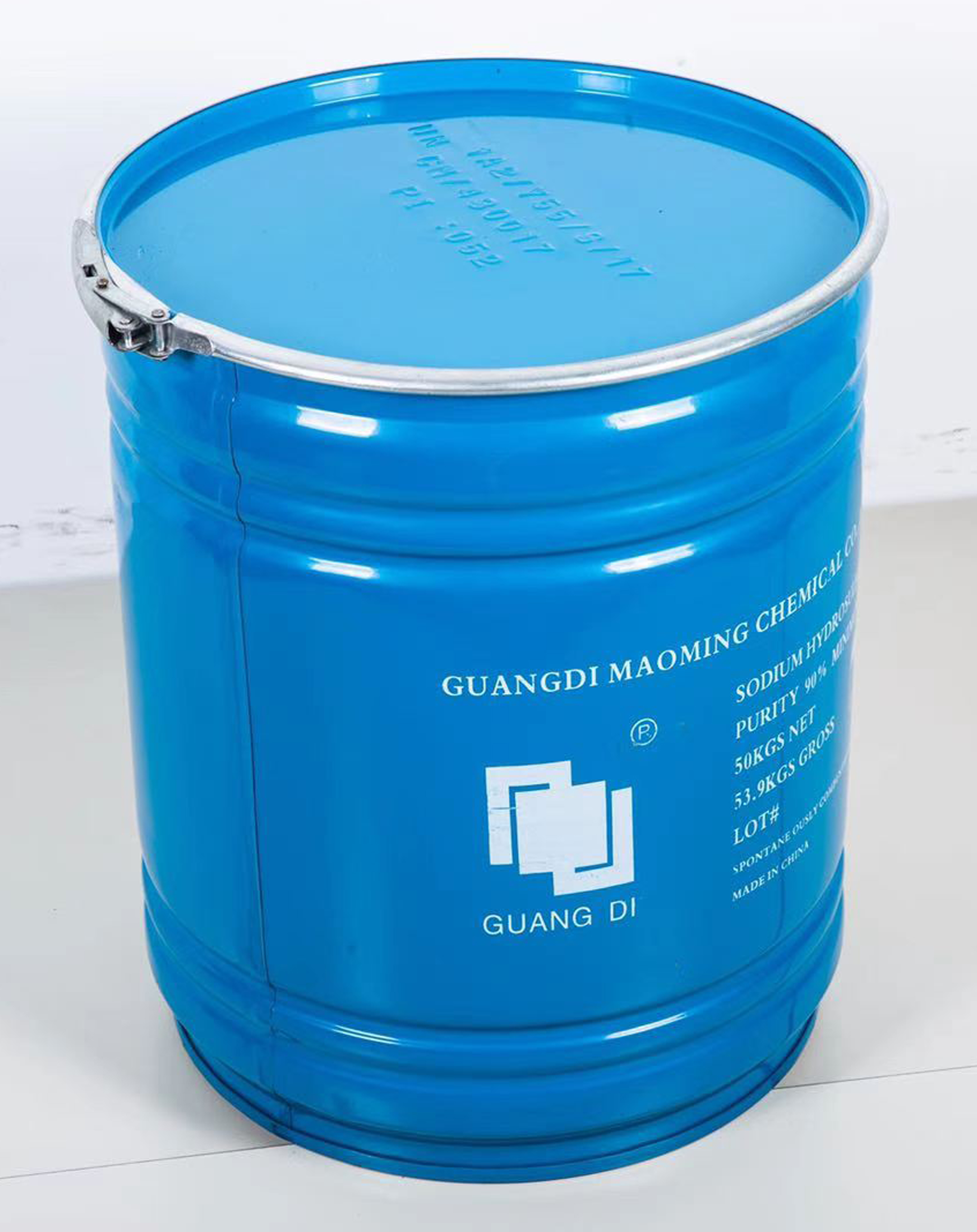
Sodium Hydrosulfite 88%
Reducing Agent, Sulfonating Agent, Textile Dyeing, Pulp and Kaolin Bleaching, Leather, Foods and Beverages, Polymers, Photograghics, Chemical processing, cleaners, water treatment, gas purification, and environmental improvement.
Sales SpecificationPackage
50 KG Iron Drum, 21 M. ton in 20 FT FCL
Proper shipping name: Sodium Dithionite
UN No.: 1384
Hazard Class: 4.2
Packing Group: II
Sodium Hydrosulfite 90%
Textile dyeing,reduction cleaning and etc.
Properties: The bulk specific weight is 0.7-1.0g/m3 , dissolve in water, slightly dissolve in ethanol. Give off heat and cause combustion easily. Spontaneous decomposition occurs when the temperature is higher than 85℃, heats up to 190℃cause detonation. Self-ignition point is 250℃.
Items |
Specifications |
Appearance |
Free-flowing white crystalline powder |
Chemical Formula |
Na2S2O4 |
Molecular wt |
174 |
Bulk Density |
0.9 |
Melting Point |
>300℃ (Decomposes) |
Solubility |
Soluble in water, insoluble in alcohol and methanol |
Odour |
None or slightly smell of sulfur dioxide |
Shelf Life |
12 months from the date of packing if stored in a sealed Air-tight container
|
Grades(Contents) |
High Purity-----------90% Min. |
Application |
i)Strong Reducing Agent. ii)Dyeing, Printing and Stripping of Vat Dyes in Textiles. iii)Bleaching Sugar, Soap, Oils, Minerals Wood Pulp, Ceramics and Chemicals. Synthetic Rubbers. iv)Discoloration of Effluent. |
Packing |
50 kg net in iron drum with double plastic liners |
Storage Stability |
Keep in closed or covered containers when not in use. Store in cool dry place with adequate ventilation. Do not store near oxidants, acids or combustible materials. |
Safety Precautions |
In case of fire, use sand or use Carbon Dioxide fire
extinguisher. Do not use water.
|
Shipping Details |
One FCL of 20 Feet can accommodate 21 MT |
UN No |
1384 |
IMCO Class |
4.2 |
IMDG Page |
4262 |
HS CODE |
2831.101 |
CAS No. |
7775-14-6 |
Package Class |
II |
Warning |
Flammable! May spontaneously ignite in moist air or upon contact with water |
Sodium Sulphate Anhydrous
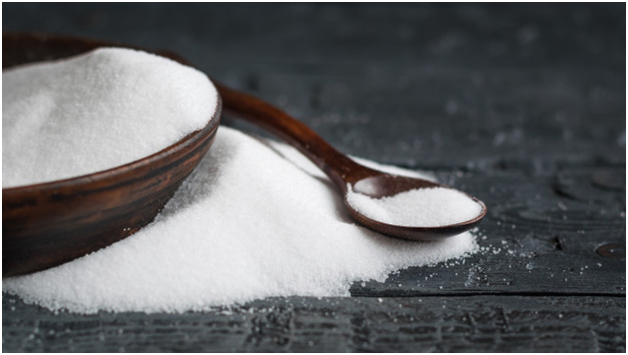
Anhydrous sulfate is a white crystalline solid also known as the mineral thenardite, while the decahydrate Na2SO4.10H2O has been known as Glauber’s salt or mirabilis.
Na2SO4.7H2O is transformed to mirabilite when it is cooled. Mirabilite is the natural mineral form of the decahydrate. About two-thirds of the world’s production of sodium sulfate is obtained from mirabilite. It is also produced from by-products of chemical processes such as hydrochloric acid production

Specifications |
Standard |
Purity (as Na2SO4) |
99.5% min. |
Water Insolubles |
0.1% max. |
Mg |
0.3% max. |
Chloride (as Cl-) |
0.7% max. |
Iron (as Fe) |
0.01%max. |
Moisture |
0.5%max. |
Whiteness |
85%min. |
- Purity
- Optimum quality
- No side effects
- Long shelf life
- Effectiveness
- Accurate composition
- Highly effective
- Premium quality
- Manufacturer of Kraft Paper & Paperboard
- Manufacturer of Glass
- Filler in Synthetic Detergents
- Sodium Salts
- Ceramics Glazes
- Processing Textile Fibbers
- Dyes
- Tanning
- Freezing Mixtures
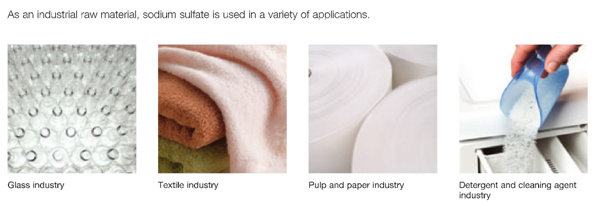
Uses: Used as materials for synthetic detergent, glass, paper making, inorganic salts, dyestuff, alcohol fiber, tanning, metal smelting, surface treatment and filler industries etc. Packing: In 25 kg, 50 kg pp bag or 1.0 mt jumbo bag
Soda Ash
Not everyone knows what soda ash is. But without it, the manufacturing of necessary materials such as glass, paper and detergents would not be possible. You will even find this versatile compound in your kitchen – in the form of baking soda, used in delicious baked goods.
Today, soda ash consistently ranks as one of the top ten inorganic chemicals produced in the world and is an essential raw material to a variety of industries.
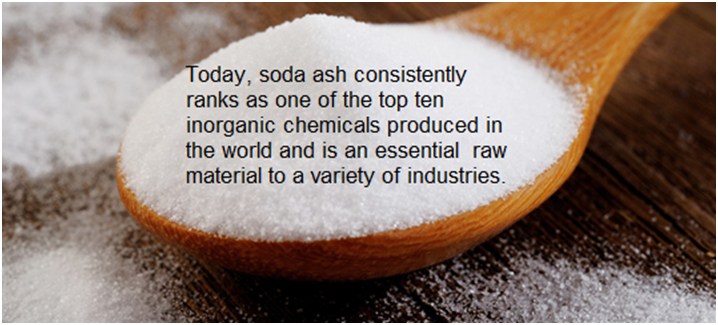
• Light Ash. • Dense Ash. • Refined Sodium Bicarbonate.
Soda Ash is used as a builder or filler in the formulation of soaps, detergents, and other cleaning compounds. In the glass industry it is used to bring down the melting temperature of silica sand (the main raw material of glass). In the paper industry, soda ash is used in the preparation of the sodium sulphite buffer liquid used in the pulp manufacturing process. Soda ash even finds an application in the water treatment segment, by adjusting the pH of water when it is acidic.
Uses Light soda ashLight soda ash is an important basic industrial chemical, widely used in fixed alkali manufacturing of products such as glass, sodium salts, soap, sodium silicates, detergents, bicarbonates, pulp and paper, iron and steel, aluminum, cleaning compounds, water softening chemicals, and textile dyes.
Dense soda ashDense soda ash is an important industrial chemical used in the glass, silicate, detergent, and other industries.
Refined sodium bicarbonateRefined sodium bicarbonate, also known as baking soda, is used in the manufacture of specialty bakery items, textiles, chemicals, oral care products, deodorizers and personal care products. It is also used for vegetable cleaning applications and in the blasting of metals.
Properties and Manufacturing Soda ash LightLight ash is produced using the ammonia-soda process, popularly known as the Solvay process. Common salt and limestone are the key raw materials processed and converted into soda ash and calcium chloride. Light soda ash is a white, odorless, uniform product which has a tendency to absorb moisture from the atmosphere. • Chemical Formula: Na2CO3 • Common Names: Sodium Carbonate, Calcined Soda, Disodium Carbonate
Dense Soda AshDense soda ash is mainly sodium carbonate with two water molecules and is produced by densification and crystallisation of light ash. Its density is almost double that of light ash. Dense soda ash dissolves readily in hard and soft water • Chemical Formula: Na2CO3 .nH2O • Common Names: Sodium carbonate, calcined soda, disodium carbonate
Refined sodium bicarbonateRefined sodium bicarbonate is formed when wet crude bicarbonate is calcined and is dissolved to form slurry. Slurry is then filtered and polished in the filtering equipment. The clear solution is then carbonated in a carbonation tower to form sodium bicarbonate crystals which are centrifuged, washed, dried and packed. • Chemical Formula: NaHCO3 • Common Names: Baking Soda, Sodium Hydrogen Carbonate, Sodium Acid Carbonate
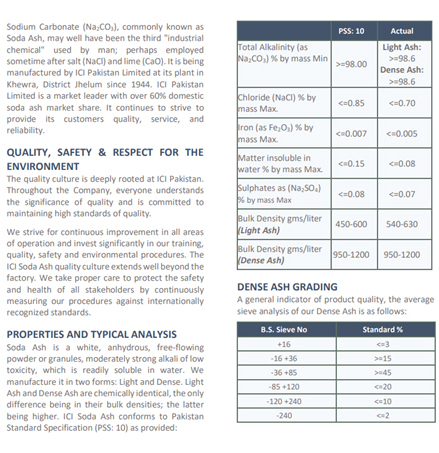
As the production capabilities have changed and evolved, so have the various markets and applications for Soda Ash. Today Soda Ash consistently ranks as one of the top 10 inorganic chemicals produced in the world and is an essential raw material in a variety of industries. In the Pakistan market it is largely consumed as an industrial raw material for the manufacture of.
TEXTILESoda Ash is used in textiles as a cleaning agent. It is used in the refining or bleaching process of textile industries. Additionally, it is used in fiber dyeing for creating optimum conditions, and as a fixing agent where reactive dyes are used.
GLASSSoda Ash is used in all types of Glass manufacturing. The principal use of Soda Ash in the Glass industry is to bring down the melting temperature of Silica Sand (the main raw material). Soda Ash, with its low melting point and reactivity, acts as a flux for other ingredients, primarily Silica and other oxides, allowing them to be melted at lower temperatures.
PAPERThe principal use of Soda Ash in the Paper industry is in the preparation of the Sodium Sulphite buffer liquid which is used in the pulp manufacturing process.
DETERGENTSSoda Ash is used primarily as a builder in the manufacturing of detergents.
SODIUM SILICATESoda Ash constitutes the main raw material for manufacture of Sodium Silicate. Sodium Silicate is mainly used for manufacturing of laundry soap and detergent amongst other usages in iron & steel industry, textile, oil & gas, and others .
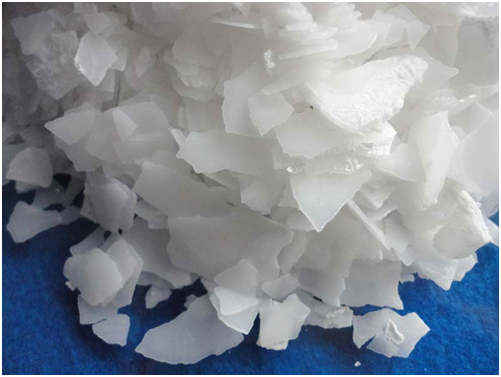

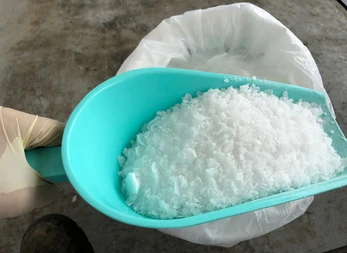
Caustic Soda Flakes / Liq
Caustic soda flake , Sodium hydroxide (NaOH) an inorganic compound with following synonyms.
• Caustic soda • Caustic Soda Liquid • Sodium hydrate
caustic soda flake widely used inorganic industrial chemical. Sodium hydroxide is having certain properties like Sodium hydroxide’s chemical formula is NaOH NaOH molecular weight of 39.997 g/mol Sodium hydroxide is contain ph of ~12-14 Sodium hydroxide characteristics can be mentioned as
• Raw material for various industrial products • Co-product in chlorine synthesis • Strong base • Highly corrosive • Auxiliary chemical • Odorless material
Caustic soda is available in two forms – Caustic soda lye Caustic soda solid. Solid form of caustic soda can be in the form of Caustic soda flakes or Caustic soda granules Pure form of sodium hydroxide also available as Caustic soda has wide variety of industrial sectors like In pulp and paper processing industry caustic soda used at the stages like bleaching process, in de-inking of waste paper, and in water treatment. Next major industry like textile industry caustic soda is used to process cotton and synthetic fibers Caustic soda is utilized more in the soap and detergent industry. Other caustic soda uses include.
• In oil and gas industry – to remove pungent smells • In household cleaning products • In beverage bottles • In home soap making
Worldwide there is high demand for caustic soda and increase in caustic soda prices applications in daily lives this article gives the different modern caustic soda manufacturing processes. Sodium Hydroxide solutions. are produced by three different technologies
• Mercury cells • Membrane cells • Diaphragm cells
Each of above processes utilizes sodium chloride (NaCl) salt as the primary raw material. Electrolytic splitting of salt results in products like chlorine and sodium ion (Na+). In turn Na+ will react with water in the mercury cell to form Sodium hydroxide and Hydrogen as by product.
Glacial Acetic Acid 99.9%
Glacial acetic acid is a name for water-free ( anhydrous) acetic acid. Similar to the German name Eisessig ( ice vinegar ), the name comes from the ice-like crystals that form slightly below room temperature at 16.6 °C (61.9 °F) (the presence of 0.1% water lowers its melting point by 0.2 °C). 3COO− ), is thus represented as AcO−
Glacial Acetic acid Pure and it's a colorless liquid that absorbs water from the environment, and freezes at 16.7 °C to a colorless crystalline solid. It is a weak acid, and is known as Glacial because on freezing it forms needle shape crystals. It is a clear, colorless liquid with a pungent odor. It is the obtained by the destructive distillation of wood, by the oxidation of acetylene and water by air, and by the oxidation of ethyl alcohol by aerobic bacteria, as in the production of vinegar. Glacial acetic acid is strongly corrosive and potentially flammable, having a low flash point. Home vinegar is five percent by mass acetic. Dilute acid acetic in the form of vinegar has many home and culinary purposes.
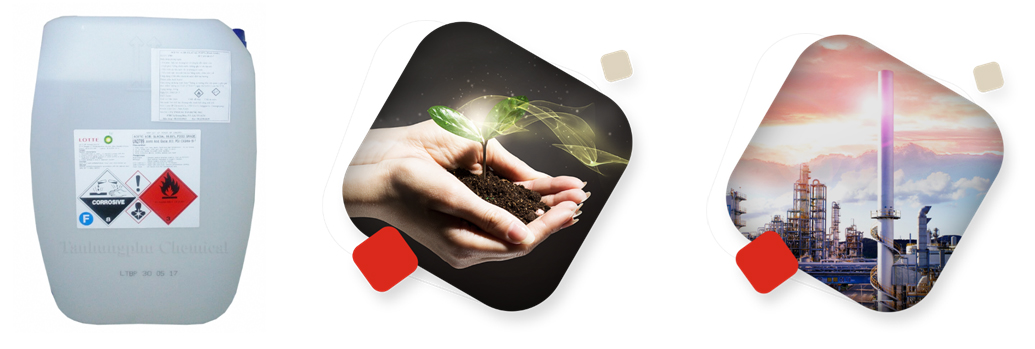
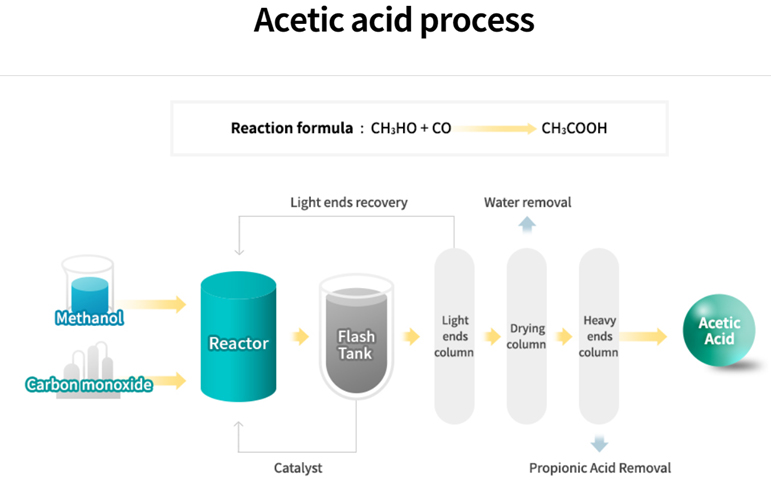
Acetic Acid are primarily used in Pharmaceuticals, Agrochemicals, Textiles, Drugs and Dyes Industries.
• Dilute Acetic Acid is used as a preservative in the preparation of pickles
• Acetic Acids are used for making cellulose acetate which is an important artificial fibre
• Glacial Acetic Acid is used in the manufacture of acetone and esters used in perfumes
• Acetic Acid glacial is used in the preparation of dyes
Acetic Acid Glacial |
99.85 per cent min. by wt |
Water |
00.15% maximum |
Colour |
10 APHA maximum |
Formic Acid or Methanoic |
0.05 % maximum by wt |
Acetaldehyde |
0.05 per cent maximum by wt |
Heavy Metals as Pb |
Less than 2 ppm. |
Iodides |
40 ppb maximum. |
Permanganate |
2.00 hrs. minimum. |
Freezing Point |
16.4° C. |
Specific Gravity |
1.049 at 25° C |
CAS No |
64-19-7. |
UN No |
2789. |
Acetic Anhydride |
Monochloro Acetic Acid |
Vinyl Acetate Monomer (VAM) |
Acetates |
Purified Terephthalic Acid (PTA) |
Diketene Derivatives |
• Acetic Acid is utilized in textile industries for textile processing and also printing. • Acetic Acid Glacial is broadly used as a preservative in food industry.
Packaging and SupplyIn 30 kgs (Net). HDPE Carboys
Hydrogen Per Oxide
Hydrogen Peroxide (H2O2) is widely used in applications ranging from household & healthcare, to semi conductor, display business and more.
• Product Name Hydrogen Peroxide • Chemical Formula H2O2 • CAS No 7722-84-1
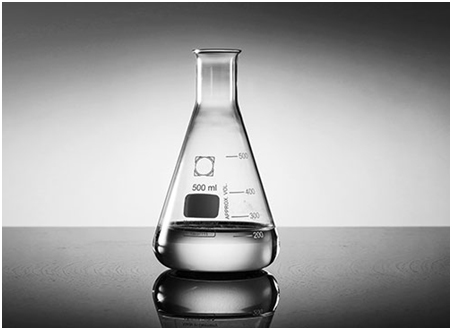
Hydrogen Peroxide (H2O2) has been used in a wide range of fields as an environmentally friendly oxidant in various industries. It is used mainly for bleaching textiles and wood pulp, and also widely used for soil remediation and wastewater disposal due to eco-friendliness. In particular, high purity Hydrogen Peroxide is used for etching and cleaning purposes in industries such as semiconductors, displays and solar energy.
Hydrogen Peroxide is produced by hydrogenation, oxidation and extraction processes. Hydrogen Peroxide of various purity by controlling processes of concentration and dilution.
Hydrogen peroxide is commonly used today in the bleaching of textile fibers. It can be used under very different processing conditions depending on fibers and manufacturing process. Hydrogen peroxide in 35% and 50% concentrations is particularly suited to the bleaching of textile fibers (natural or synthetic). The decomposition products of hydrogen peroxide are oxygen and water, which can reduce water consumption and improve effluent treatment. Hydrogen peroxide bleaching improves the consistency of dye transfer to the fabric. Cotton bleached with hydrogen peroxide has a stable whiteness, a soft touch and an absorbency that improves the dyeing of the fabric.
Hydrogen peroxide is one of the most widely used disinfectants for sterilizing cardboard and plastic packaging materials intended for contact with food products. Most aseptic packaging systems use hydrogen peroxide at a concentration of 35%, more rarely at 25%. Disinfection achieved with hydrogen peroxide does not lead to any toxic by-products (only water and oxygen) and the small excess of hydrogen peroxide is removed when drying the packaging with hot sterile air. No additional rinsing with sterile water is required, unlike some other chemicals. Arkema has developed a wide range of hydrogen peroxide solutions called Valsterane®, suitable for all aseptic technologies: “Bath technology”: the packaging material (cardboard rolls or plastic film) is taken from a reel and dipped into a bath of aqueous 35% hydrogen peroxide whose temperature is generally 60 to 85°C, depending of the aseptic machine. Contact time with the solution is a few seconds and excess solution is removed by squeeze rolls and/or air jets after removal of the material from the bath, which leaves a thin film of solution that is then dried by hot air. In bath aseptic technologies, hydrogen peroxide stability is the key parameter. “Spray technology”: this is the method for preformed cardboard containers, plastic bottles and plastic preforms whereby hydrogen peroxide is sprayed in the form of small dispersed droplets. Further hydrogen peroxide vaporization ensures the complete sterilization of the inner surface of the packaging, and further hot sterile air drying removes hydrogen peroxide residue. In spray aseptic technologies, hydrogen peroxide dry residue is the key parameter. Valsterane® is even is versatile enough to meet the 2 technologies requirements. Furthermore, hydrogen peroxide can also be used as a bleaching agent in the food industry based on local regulations.
Hydrogen peroxide is increasingly used in household cleaning as a green replacement for chlorine based products. It is commonly used for: - Bleaching organic stains - Removing laundry grayness - Delivering antimicrobial benefits (used as a biocide). Hydrogen peroxide is also used in laundry prespot, auxiliary bleach, hard surface formulations, dishwashing, liquid detergents, institutional and industrial cleaning, and in the production of solid peroxygens (i.e. sodium percarbonate and sodium perborate) use in powder laundry detergents. With changes in washing conditions (i.e. energy dependent drive to colder wash temperatures), sodium percarbonate has been found to be the product of choice for lower wash temperatures. Formulating with hydrogen peroxide in cleaning products requires an understanding of stability and compatibility with other ingredients (i.e. surfactants, dyes, other additives and formulation pH). Arkema offers a family of peroxygens (e.g. mild to aggressive oxidants) and a range of specialty products (e.g. alkaline stable, gel, antimicrobial and their proprietary products). Arkema also offers powerful peroxygen products. Hydrogen Peroxide from Arkema can be used as a biocidal active substance or as a biocidal product. Our experienced technical staff can offer specific formulation knowledge and performance testing capabilities.
Synthesis of peroxides The peracids (peracetic acid, perpropionic acid) are produced by oxidation of the corresponding acids by hydrogen peroxide, in the presence of an acidic catalyst. Epoxidation of double bounds C=C Different routes are available to carry out epoxidation of double bond C=C: epoxidation by hydroperoxides, epoxidation by peracids and epoxidation by hydrogen peroxide. Hydroxylation of phenols Hydrogen peroxide is an efficient chemical for the hydroxylation of aromatic rings. Thanks to its high selectivity towards monohydroxylation, after its activation with an acidic catalyst, hydrogen peroxide is a preferred route for the production of hydroquinone and catechol. Oxidation of amines and hydrazine hydrate Arkema has a wide range of Albone® commercial hydrogen peroxides grades, which perfectly meet the requirements of the reactions described above. Our customers may choose the hydrogen peroxide concentration, which allows them to guarantee the safety of the process and, in some cases, a distilled grade (low content of carbon and of stabilizer). Mining In mining applications, hydrogen peroxide is used to increase the extraction rate. Metal treatment At the surface of metals, some oxides are resistant to most standard acidic treatments. In this respect, hydrogen peroxide proves to be a very effective way eliminate of these impurities.
Currently, the two major bleaching agents used in the pulp and paper industry are hydrogen peroxide and sodium chlorate. Hydrogen peroxide is used across a wide range of pulp productions including chemical (both hardwood and softwood), mechanical and recovered fibers, in addition to the bleaching of annual plants, like bagasse and rice straws. As far as sodium chlorate is concerned, it is only used in the production of chemical pulp. Mechanical pulps In the manufacturing process of mechanical pulps i.e. SWG pulp (Stone Wood Ground), TMP pulp (Thermo Mechanical Pulp), CTMP pulp (Chemi Thermo Mechanical Pulp) and APMP pulp (Alkaline Peroxide Mechanical Pulp), hydrogen peroxide plays a key role in the development of the optical properties. Hydrogen peroxide remains the main bleaching agent of mechanical pulps. Applied alone or in combination with other bleaching agents, it ensures optimal whitening performance. Chemical pulps Sodium chlorate is the main bleaching agent on ECF (Elemental Chlorine Free) sequences, whereas hydrogen peroxide is the leading chemical in TCF (Total Chlorine Free). In these two bleaching processes, these products are the key agents to ensure a high degree of brightness while minimizing the impact of wastes. Sodium chlorate is an on-site generator for chlorine dioxide. Chlorine dioxide is an efficient delignification and bleaching agent in ECF (Elemental Chlorine Free) bleaching sequences for all types of chemical pulp, kraft or sulfite. It enables ECF pulps to reach a high and stable brightness together with excellent mechanical properties and for minimum cost and high yield. Recycled pulps Hydrogen peroxide is used as a bleaching agent, alone or in combination with other oxidizing or reducing agents, in the pulping stage of recovered paper, ensuring therefore a very high degree of brightening effect. When it comes to the numerous reactions in organic chemistry, hydrogen peroxide is used in many of them and the most important include the following: peroxides (peracids, hydroperoxides, diacyl peroxides), epoxidation of olefins, hydroxylation of phenols, oxidation of amines and hydrazine hydrate.
Sodium Bicabonate

A thousand opportunities to serve you
In 1863, Chem Color Intl discovered a new process for manufacturing sodium carbonate using sea salt, ammonia and carbonic acid.
This process produced a sodium bicarbonate of high purity,which is used today in many fields: food, detergents, health and remediation.
Overtime,the group has grown and now Chem Color Intl, with a presence in 55 countries on five continents, is the world leader in sodium carbonate and bicarbonatewith manufacturing plants in theUnited States and Europe.
Throughout this brochure, you will discover the amazing properties of Chem Color Intl bicarbonate and the numerous services this miraculous product can offer you every day.
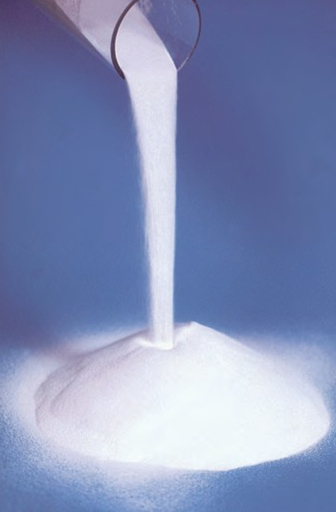
From food to detergent, sodium bicarbonate is an all-purpose product with a thousand uses. you will find the most common uses, dosages and advice that will provide users with a simple, natural and effective practical help, for some everyday situations.
It contains only sodium bicarbonate, a white and extremely pure product. It is biodegradable and environmental friendly; it can be found in nature and plays a fundamental role in the human body. Its purity is a guarantee of its quality!
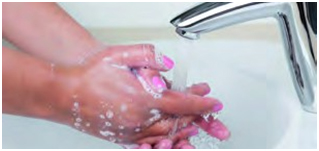
• Fruit and vegetables • Saucepans, kitchenware and cutlery • Delicate surfaces without scratching
In order to eliminate impurities, wax and other possible residues, do not forget to wash your fruit and vegetables with water and sodium bicarbonate before consumption.





Sodium Nitrate
Sodium nitrite, with chemical formula NaNO2, is used as a color fixative and preservative in meats and fish. When pure, it is a white to slight yellowish crystalline powder. It is very soluble in water and is hygroscopic. It is also slowly oxidized by oxygen in the air to sodium nitrate, NaNO3. The compound is a strong oxidizing agent.
It is also used in manufacturing diazo dyes, nitroso compounds, and other organic compounds; in dyeing and printing textile fabrics and bleaching fibers; in photography; as a laboratory reagent and a corrosion inhibitor; in metal coatings for phosphatizing and detinning; and in the manufacture of rubber chemicals. It may also be used as an electrolyte in electrochemical grinding manufacturing processes, typically diluted to about 10% concentration in water.
Sodium Nitrite SpecificationsTest |
Limits |
Appearance |
White to off-white crystalline powder |
Purity (On dry basis) by KMnO4 titration |
99.00 % w/w Min |
Loss on drying at 110ºC for 10 min |
0.50 % w/w Max |
Alkalinity as Na2CO3 or NaOH by H2SO4 titration - 0.20 % w/w Max |
|
Chloride as Cl by Nitrobenzene |
0.10 % w/w Max |
Sodium Nitrate by PDSA |
1.00 % w/w Max |
Water insoluble |
0.05 % w/w Max |
Sulphate as SO4 by turbidity |
0.08 % w/w Max |
Iron as Fe by Potassium thiocyanate |
0.002 % w/w Max |
Heavy metal as Pb by visual colourimetric |
0.005 % w/w Max |
Clarity of 30% aqueous solution |
It should be clear solution |
The material can also be offered with anti-caking agent.
Sodium Nitrite BP Pharmacopoeia
NaNO2
Action and use
Used in treatment of cyanide poisoning.
Content
98.5 per cent to 100.5 per cent (dried substance).
Appearance
Colourless crystals or mass or yellowish rods, hygroscopic.
Solubility
Freely soluble in water, soluble in alcohol.
A. Dilute 1 ml of solution S1 (see Tests) to 25 ml with water R. To 0.1 ml of the solution add 1 ml of sulphanilic acid solution. Allow to stand for 2-3 min. Add 1 ml of b-naphthol solution and 1 ml of dilute sodium hydroxide solution R. An intense red colour develops.
B. To 1 ml of the solution prepared for identification test A add 3 ml of a 20 g/l solution of phenazone and 0.4 ml of dilute sulphuric acid. An intense green colour develops.
C. To 0.15 ml of solution S1, add 0.35 ml of water R. The solution gives reaction of sodium.
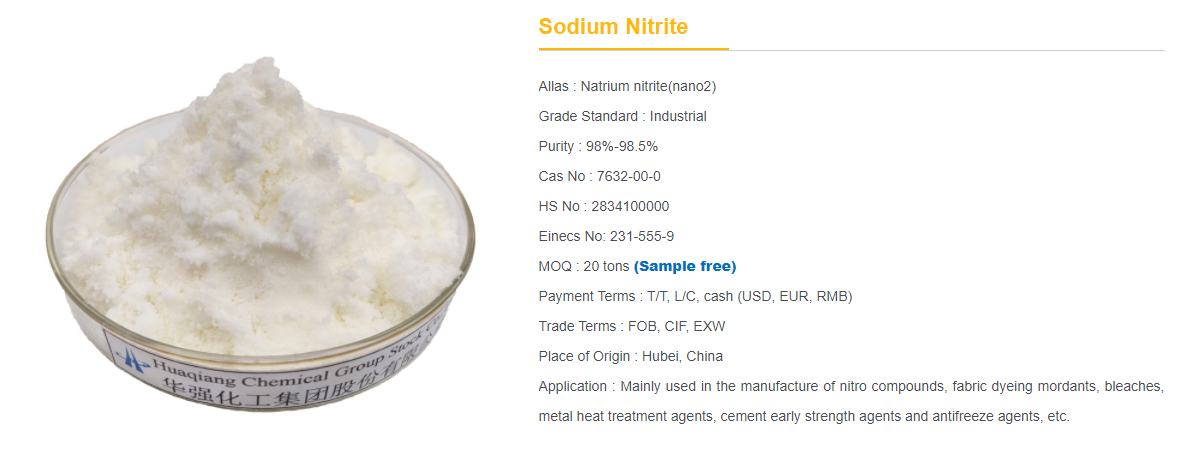
Quality Standard
Test items | Quality Index | ||
High-class | First-class | Qualified | |
Appearance | White or yellowish crystals | ||
Sodium nitrite content (in dry basis) % | 99.0 | 98.5 | 98.0 |
Sodium nitrate content (in dry basis)% | 0.8 | 1.3 | / |
Chloride( NaCL)in dry basis % | 0.10 | 0.17 | / |
Moisture % | 1.4 | 2.0 | 2.5 |
Water insoluble matter content(in dry basis)% | 0.05 | 0.06 | 0.10 |
Degree of looseness (in terms of non-caking)% | 85 | ||
The product implementation standard is GB/T2367-2016 | |||
Package Delivery
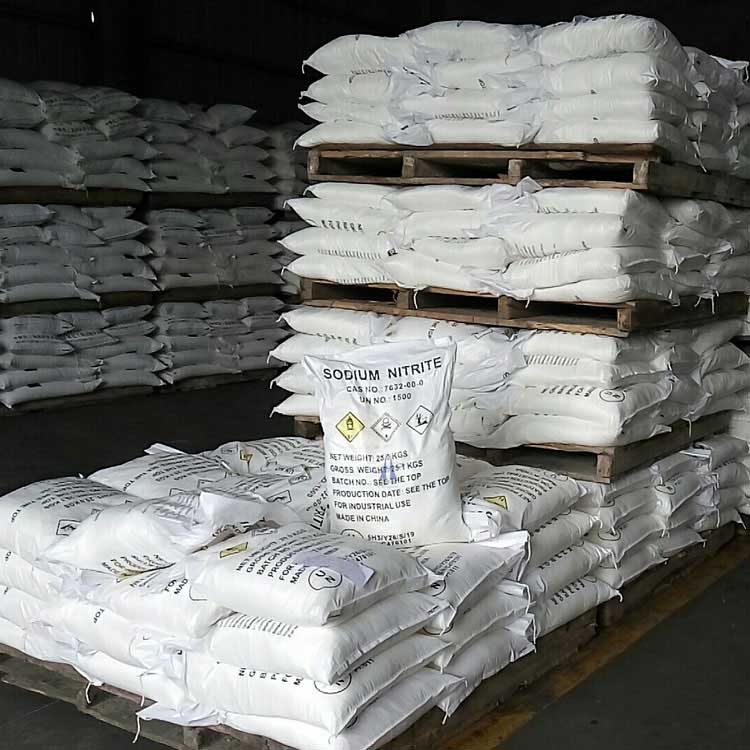
Formic Acid
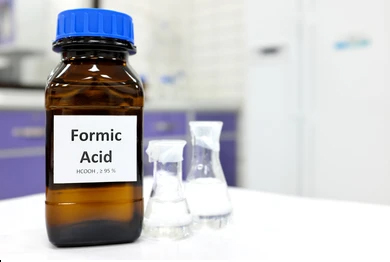
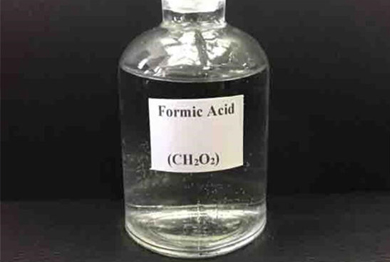

Formic acid is a colourless, fuming liquid with a pungent odour; it irritates the mucous membranes and blisters the skin. It freezes at 8.4 °C (47.1 °F) and boils at 100.7 °C (213.3 °F).
Formic acid is widely used in diversified industries all over the world. In medical industry it is used in making Amidopyrin, Vitamin B and many other medicines. In chemical industry, Formic Acid is used in the production of methanamide, diethyl formamide, rubber age resister, dying and so on. It is also an important material for pesticide, such as Triazone. Besides, formic acid is also commonly used in silage.
ITEMS |
VALUE |
Color(pt-co) |
5 MAX |
chloride(cl) |
0.0005% MAX |
Sulphate (SO4) |
0.0005%MAX |
Iron ( Fe ) |
0.0001%MAX |
Evaporation residue |
0.004 %MAX |
Formic Acid is used in textile processing to control the pH of waste-water
(neutralization of the pH and the excess NaOH from manufacturing process).
Formic acid is used in several steps of leather processing. Methods for processing leather involve steps of preparing skins for tanning, optionally dyeing the leather and finishing if required.
One of the traditional uses of formic acid is the coagulation of natural rubber, which is produced primarily in south-east Asia. Latex milk is tapped from rubber trees and is mixed with formic acid to produce the coagulated rubber that is further processed into tires and numerous other rubber products.
- Households: descaling, and cleaning of bathroom surfaces
- Industrial cleaning: cleaning and descaling of equipment and tanks (e.g., in breweries), corrosion removal
- Others: wine casks, dairies
- Feed & drinking water: In animal feed additives, formic acid is used as a growth promoter; it acts positively on the gut flora of animals (poultry, swine, and cattle), improves feed efficiency and average daily weight gain, and reduces pathogen-caused diseases in the intestines
- Preservation & acidification of feed mixes: Formic acid has antibacterial effects, which are used to preserve and acidify feeds. Organic acids, including formic are often blended in mixtures for use as alternatives to antibiotics
- Grass silage: Prevention of bacteria and mold (lower activity than propionic acid) growth avoids spoilage in open storage structures
- Fish Silage: Formic Acid helps helps to speed up of break down of fish proteins while preventing bacterial spoilage
- Agricultural Biocides
- Flue Gas desulfurization
- Pretreatment for the conversion of sugarcane bagasse to bioethanol
- Wood adhesive
- Paper Industry
- Steep Pickling
- Paint Remover
- Process Chemical (e.g. adjustment of pH)
- Epoxidation of soybean oils: Plasticizers
- Fuell Cell
Oxalic Acid
1.In plastic woven bag 25kg net,lined with PE bag 2.In compound Kraft bag 25kg net,lined with PE bag 3.In jumbo bag.Pallet&stretch wrapped
Quality index|
Oxalic Acid Content |
99.6% Min |
99.4% Min |
99.0% Min |
|
Heavy Metals(Pb2+) |
0.001% Max |
0.002% Max |
0.02% Max |
|
Ferrous (Fe3+) |
0.0015% Max |
0.002% Max |
0.01% Max |
|
Chloride(Cl-) |
0.003% Max |
0.004% Max |
0.01% Max |
|
Ignition Residue (850¡æ) |
0.08% Max |
0.10% Max |
0.20% Max |
|
PH |
6-8 |
7.35 |
1. In Metallurgy industry:as precipitating and separating function for Rare-earth metal 2. Inpharmaceutical industry:used in Tetracyline,Oxtetracycline,Phenobarbital,and Borneol,etc 3. In Light industry: polishing for Marble,rust-remover,bleaching,dirt-remover,leather-processing,wood,and aluminium products etc. 4. In Dyeing and printing industry: as reducing agent for dyeing and printing industry,as bleaching agent for textile,substitute for Acetic acid,as coloring mordant for fast pigment dye stuff. 5. In organic synthetic:used in 2133 resin,Urea-formal dehyde molding powder,Butadiene catalyst,etc. 6. In electron industry: preparation of chemicals raw material for porcelain capacitor,preparation of electron equipment detergent
Sodium Metabisulphite
Our Principal factory is in Changsha . Xian Wang chemicals was founded in 1996 in Changsha, Annual production capacity up to 50,000 tons for sodium metabisulfite. Our company relies on strong technical force and advanced process equipment to supply high-quality products and competitive price to the customers.We persist the attitude of sincere cooperation and micro-service.The Plant is equipped with a full-time quality control system and the quantity of quality control has been reached to 10 persons,meanwhile, we bring in the advanced testing and monitoring methods to guarantee the superior products. We adhere to the quality policy--"standardized management, quality first; customer first, continuous improvement"."Quality first is our eternal theme, Quality service is our sacred duty, Customer satisfaction is our pursuit."quality goals , create first-class "HaoLin" brand.
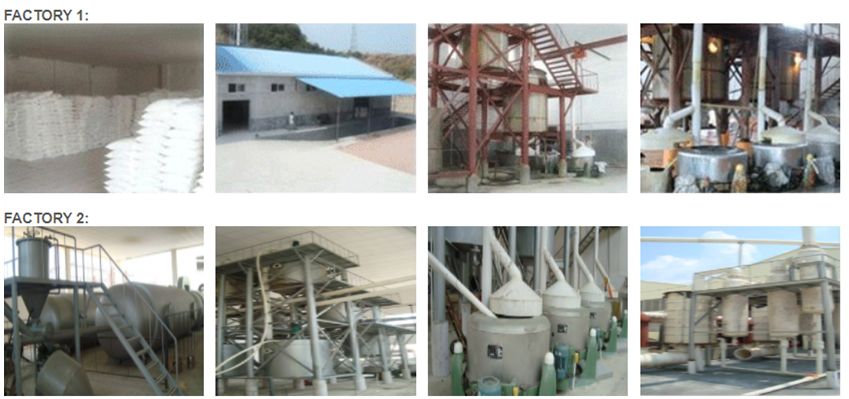
ITEMS |
UNIT |
SPECIFICATION |
Purity |
(%)min |
97 |
As |
(ppm) max |
2 |
Fe |
(ppm) max |
30 |
Pb |
(ppm) max |
5 |
Cd |
(ppm) max |
5 |
PH |
4-5 |
|
Water insolubles |
(%)max |
0.03 |
Usage
it is for printing and dyeing industry, organic synthesis, printing, leather, pharmaceutical and other sectors; in food processing as preservatives, bleaching agents, baking powder.And used in industrial mineral processing.
PackingNet 25kgs woven bags with inner liner.
StorageSealed in cool and dry place.
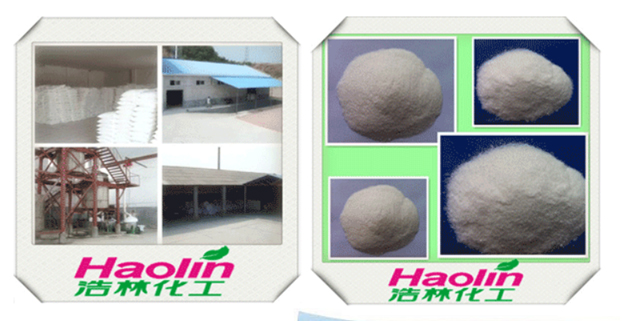
M Type reactive dyes
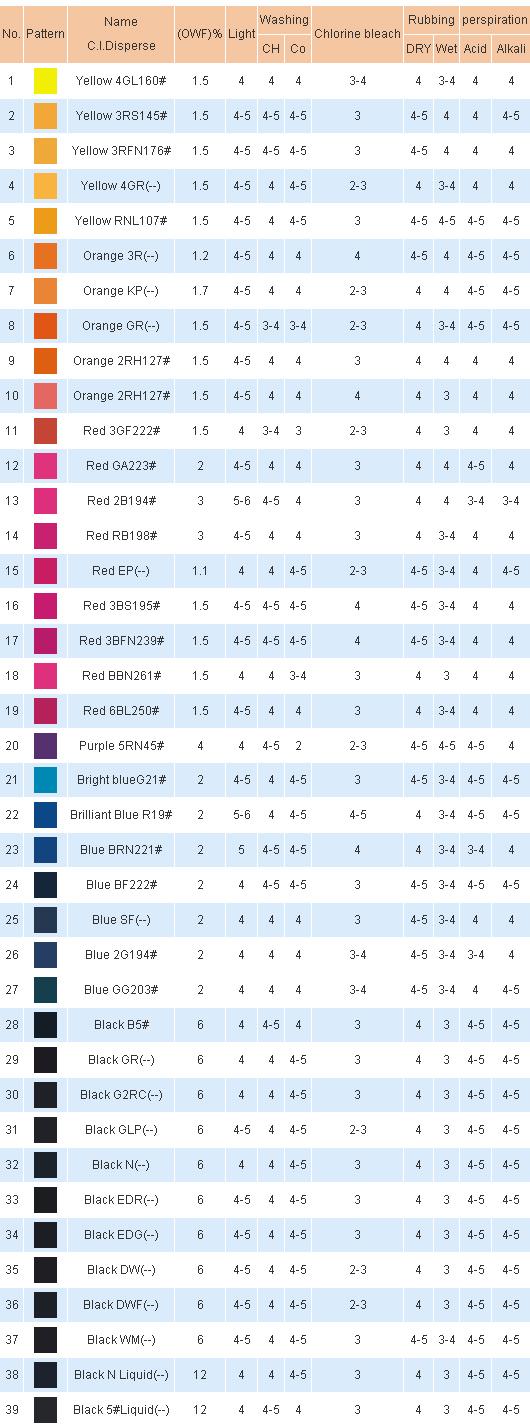
KN Type reactive dyes
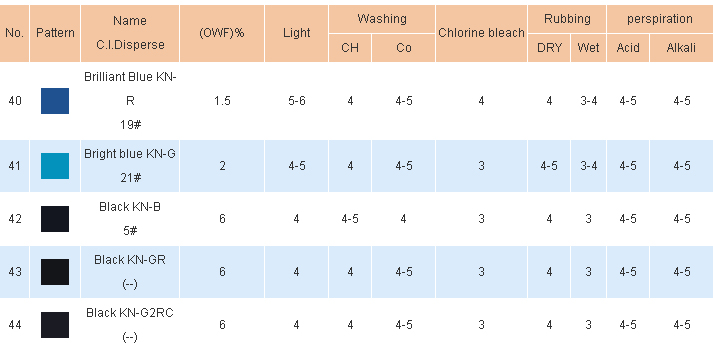
ED Type reactive dyes
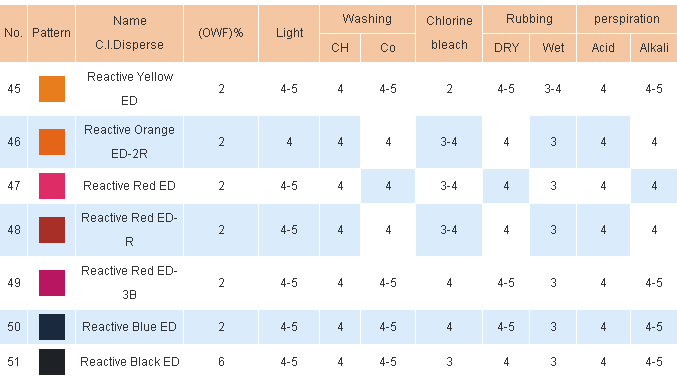
HE Type reactive dyes
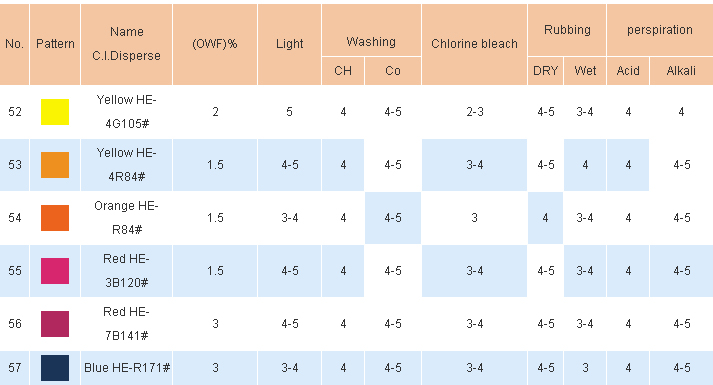
E-XF Type reactive dyes
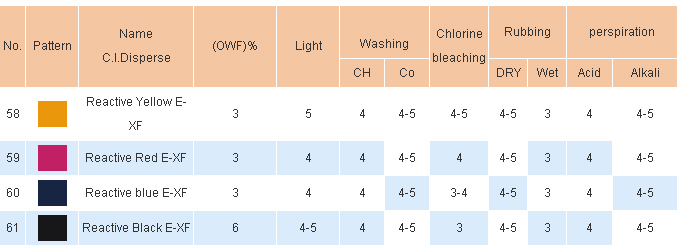
RGN Type reactive dyes
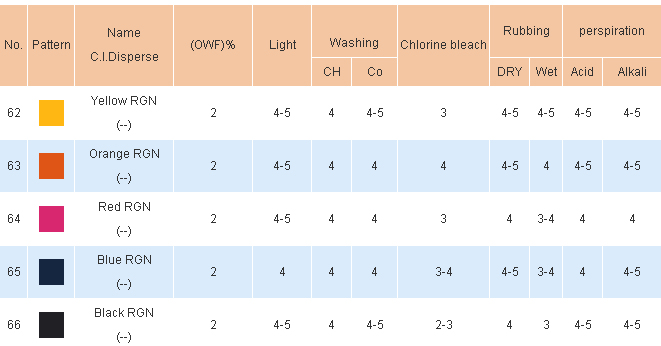
K Type reactive dyes for printing
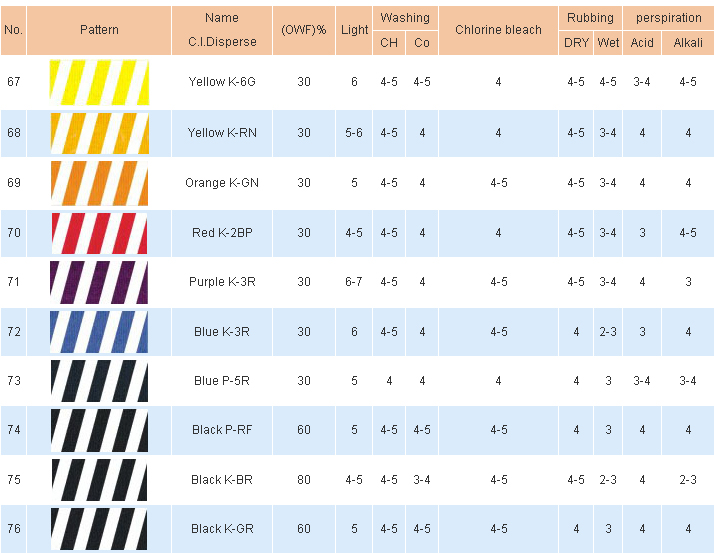
General Series

Micro Fabrics Dyeing Series
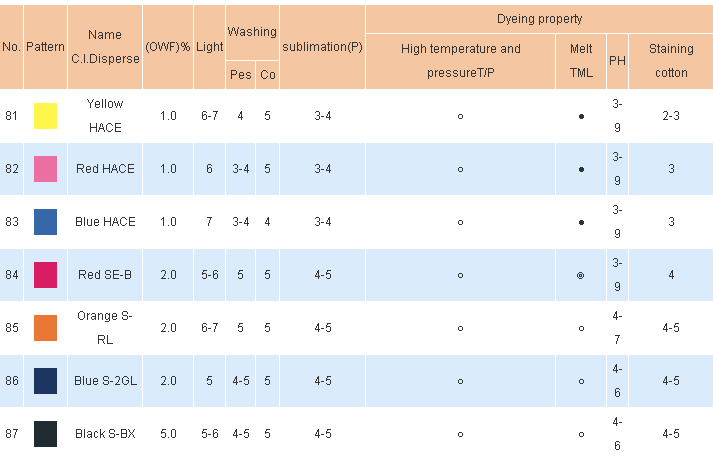
Rapid Dyeing (HRD)Series
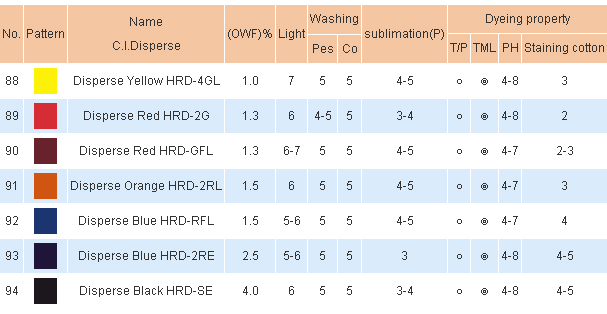
High Washing Fastness(HXF)Series
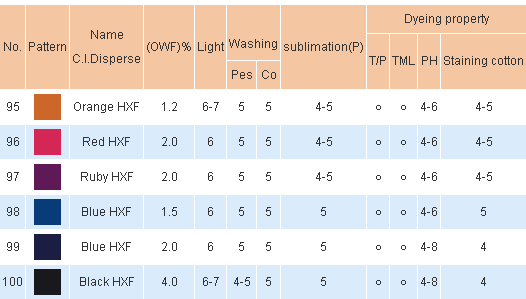
NN Series
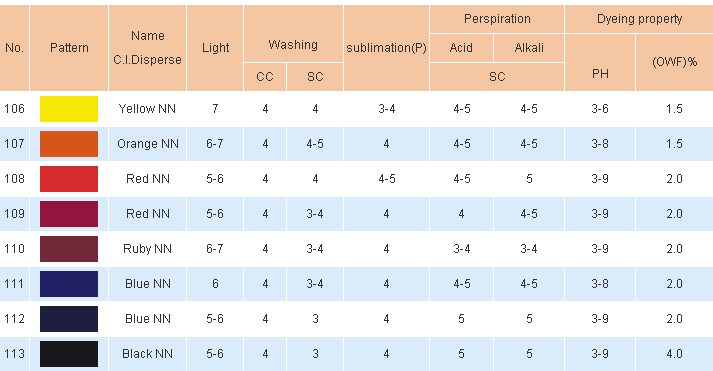
Dyestuffs For Acetate Fibers
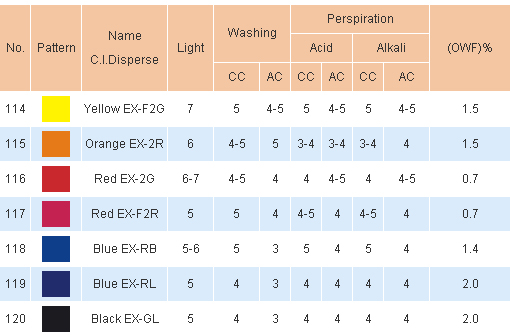
Direct Printing Series
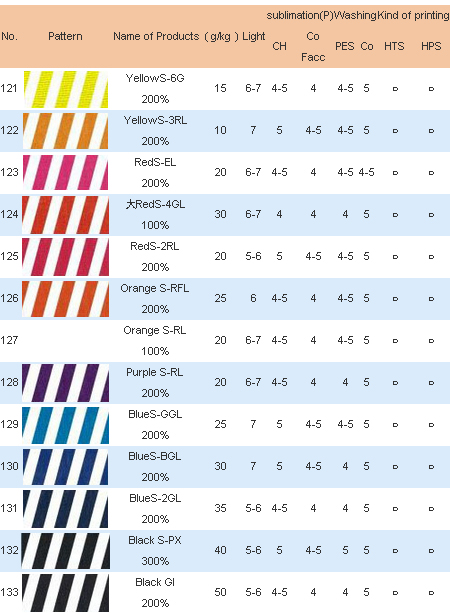
High-temperature dark Primary Colors

General-purpose series
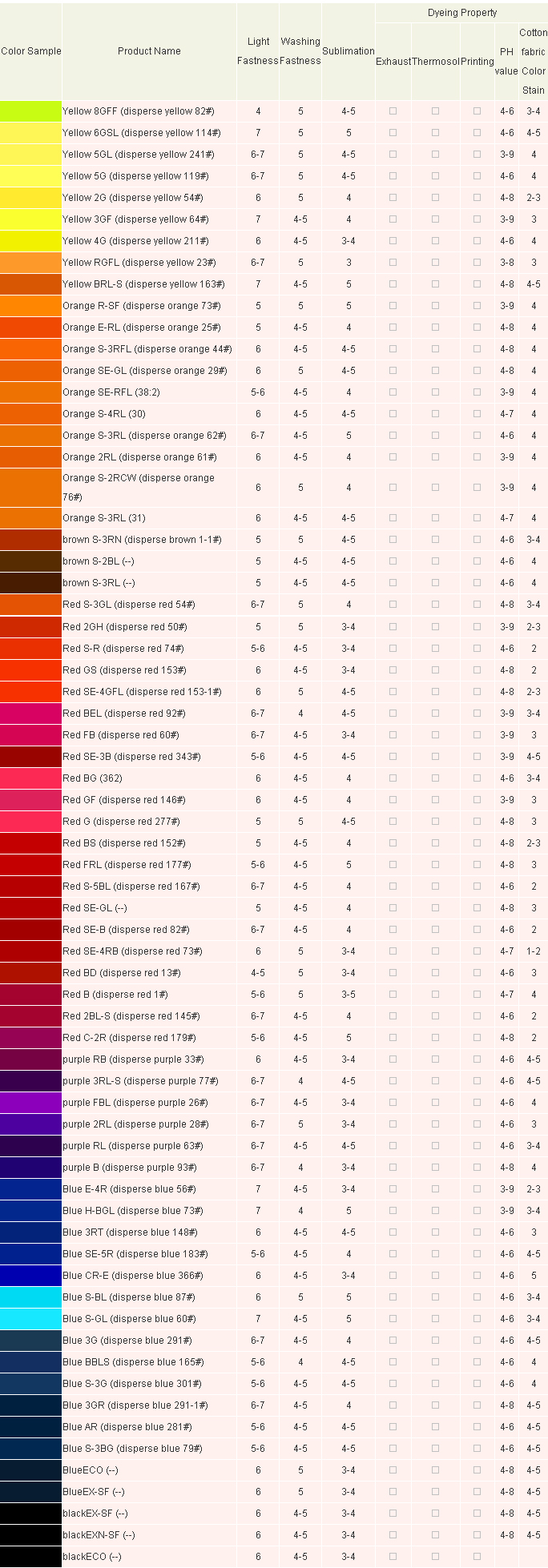
Indigo Powder
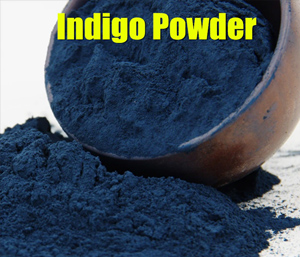
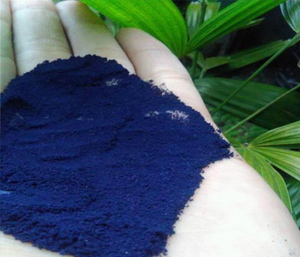
It is a kind of bleu powder reducing dye, and is the initial product of indigo. It is produced by stoving the filter cake from the former section. It is insoluble in water, ethanol and ethyl ether, but soluble inmelt benzoyl oxide. Itis mainly used in the dyeing and printing of cotton fiber, and is the special dye for jean fabric. It can also be processed into food dye and biochemical agent.
Quality index
|
Appearance |
Homogenic dark blue powder |
|
Color light |
similar as the standard sample |
|
Content,% |
≥ 94.0% ,96.0% |
|
Moisture content,% |
≤ 1.0% |
|
Strength,% |
equal to 100 percent of standard sample |
|
PH value |
7 |
|
Content of ferric ions, ppm |
≤ 200PPM |
Indigo granular
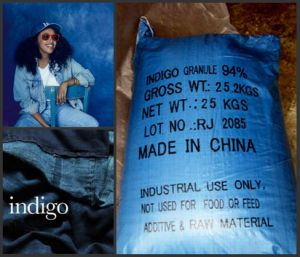
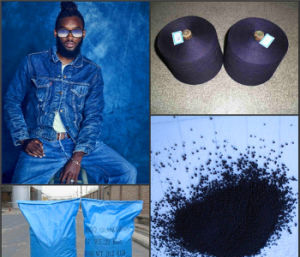
The granular indigo is processed by spray drying the slurry of acid washing indigo with additive, it has advantages of:
Free of dust or little flying dust. The granules have certain mechanical strength, and don' t create dust easily, so it can improve the working environment and sanitary condition.
Good flowability, which is beneficial to the automatic measuring and operation.
Good wettability and dispersibility, don' t agglomerate or aggregate in use, and is convenient for preparing dye liquor.
Good storage stability, and don' t absorb moisture easily, and has not electrostatic adsorption phenomenon.
It can also ensure the homogenic color and brilliant color light in printing and dyeing
Quality index
|
Appearance |
Homogenic dark blue granules |
|
Color light |
similar as the standard sample |
|
Content |
≥ 93.0%、94.0% |
|
Content |
≤ 1.0% |
|
Strength |
equal to 100 percent of standard sample |
|
pH value |
8-9 |
|
Content of ferric ions, ppm |
≤ 300PPM |
Bromo Indigo
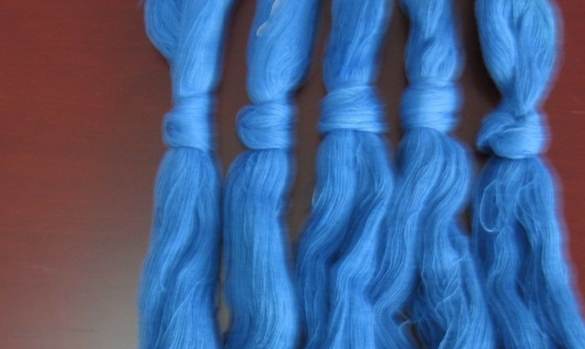

Used:
Used for dyeing and printing on cotton fabrics.
excellent fastness properties, especially high fastness to sunlight, high fastness to perspiration, and high fastness to washing and bleaching.
military uniform and clothes
hospital uniform and clothes
Discharge Printing:
Also used as pigment to make printing paste. some of the products are used for cosmetics
Sodium Sulphate Anhydrous

Anhydrous sulfate is a white crystalline solid also known as the mineral thenardite, while the decahydrate Na2SO4.10H2O has been known as Glauber’s salt or mirabilis.
Na2SO4.7H2O is transformed to mirabilite when it is cooled. Mirabilite is the natural mineral form of the decahydrate. About two-thirds of the world’s production of sodium sulfate is obtained from mirabilite. It is also produced from by-products of chemical processes such as hydrochloric acid production

Specifications |
Standard |
Purity (as Na2SO4) |
99.5% min. |
Water Insolubles |
0.1% max. |
Mg |
0.3% max. |
Chloride (as Cl-) |
0.7% max. |
Iron (as Fe) |
0.01%max. |
Moisture |
0.5%max. |
Whiteness |
85%min. |
- Purity
- Optimum quality
- No side effects
- Long shelf life
- Effectiveness
- Accurate composition
- Highly effective
- Premium quality
- Manufacturer of Kraft Paper & Paperboard
- Manufacturer of Glass
- Filler in Synthetic Detergents
- Sodium Salts
- Ceramics Glazes
- Processing Textile Fibbers
- Dyes
- Tanning
- Freezing Mixtures

Uses: Used as materials for synthetic detergent, glass, paper making, inorganic salts, dyestuff, alcohol fiber, tanning, metal smelting, surface treatment and filler industries etc. Packing: In 25 kg, 50 kg pp bag or 1.0 mt jumbo bag
Soda Ash
Not everyone knows what soda ash is. But without it, the manufacturing of necessary materials such as glass, paper and detergents would not be possible. You will even find this versatile compound in your kitchen – in the form of baking soda, used in delicious baked goods.
Today, soda ash consistently ranks as one of the top ten inorganic chemicals produced in the world and is an essential raw material to a variety of industries.

• Light Ash. • Dense Ash. • Refined Sodium Bicarbonate.
Soda Ash is used as a builder or filler in the formulation of soaps, detergents, and other cleaning compounds. In the glass industry it is used to bring down the melting temperature of silica sand (the main raw material of glass). In the paper industry, soda ash is used in the preparation of the sodium sulphite buffer liquid used in the pulp manufacturing process. Soda ash even finds an application in the water treatment segment, by adjusting the pH of water when it is acidic.
Uses Light soda ashLight soda ash is an important basic industrial chemical, widely used in fixed alkali manufacturing of products such as glass, sodium salts, soap, sodium silicates, detergents, bicarbonates, pulp and paper, iron and steel, aluminum, cleaning compounds, water softening chemicals, and textile dyes.
Dense soda ashDense soda ash is an important industrial chemical used in the glass, silicate, detergent, and other industries.
Refined sodium bicarbonateRefined sodium bicarbonate, also known as baking soda, is used in the manufacture of specialty bakery items, textiles, chemicals, oral care products, deodorizers and personal care products. It is also used for vegetable cleaning applications and in the blasting of metals.
Properties and Manufacturing Soda ash LightLight ash is produced using the ammonia-soda process, popularly known as the Solvay process. Common salt and limestone are the key raw materials processed and converted into soda ash and calcium chloride. Light soda ash is a white, odorless, uniform product which has a tendency to absorb moisture from the atmosphere. • Chemical Formula: Na2CO3 • Common Names: Sodium Carbonate, Calcined Soda, Disodium Carbonate
Dense Soda AshDense soda ash is mainly sodium carbonate with two water molecules and is produced by densification and crystallisation of light ash. Its density is almost double that of light ash. Dense soda ash dissolves readily in hard and soft water • Chemical Formula: Na2CO3 .nH2O • Common Names: Sodium carbonate, calcined soda, disodium carbonate
Refined sodium bicarbonateRefined sodium bicarbonate is formed when wet crude bicarbonate is calcined and is dissolved to form slurry. Slurry is then filtered and polished in the filtering equipment. The clear solution is then carbonated in a carbonation tower to form sodium bicarbonate crystals which are centrifuged, washed, dried and packed. • Chemical Formula: NaHCO3 • Common Names: Baking Soda, Sodium Hydrogen Carbonate, Sodium Acid Carbonate

As the production capabilities have changed and evolved, so have the various markets and applications for Soda Ash. Today Soda Ash consistently ranks as one of the top 10 inorganic chemicals produced in the world and is an essential raw material in a variety of industries. In the Pakistan market it is largely consumed as an industrial raw material for the manufacture of.
TEXTILESoda Ash is used in textiles as a cleaning agent. It is used in the refining or bleaching process of textile industries. Additionally, it is used in fiber dyeing for creating optimum conditions, and as a fixing agent where reactive dyes are used.
GLASSSoda Ash is used in all types of Glass manufacturing. The principal use of Soda Ash in the Glass industry is to bring down the melting temperature of Silica Sand (the main raw material). Soda Ash, with its low melting point and reactivity, acts as a flux for other ingredients, primarily Silica and other oxides, allowing them to be melted at lower temperatures.
PAPERThe principal use of Soda Ash in the Paper industry is in the preparation of the Sodium Sulphite buffer liquid which is used in the pulp manufacturing process.
DETERGENTSSoda Ash is used primarily as a builder in the manufacturing of detergents.
SODIUM SILICATESoda Ash constitutes the main raw material for manufacture of Sodium Silicate. Sodium Silicate is mainly used for manufacturing of laundry soap and detergent amongst other usages in iron & steel industry, textile, oil & gas, and others .
Labsa
Linear alkyl benzene sulphonic acid, also known as LABSA is a synthetic chemical surfactant, which is a widely used industrial detergent. It is used in washing powder, detergent powder, oil soap, cleaning powder and detergent cake.
LABSA is an anionic surfactant, whose molecules are characterized by a hydrophilic and a hydrophobic group. This nonvolatile chemical compound is synthesized through the process of sulfonation. The sulfonation reagents include sulfuric acid, chlorosulfonic acid, sulfamic acid and diluted sulfur trioxide. The properties of LABSA, differs in chemical and physical properties based on the length of the alkyl chain. This results in formulations, which finds many applications. The resulting surfactants are used in the chemical industry to improve contact between water and minerals.
LABSA is chiefly used in the detergent industry for the manufacture of washing powder, detergent powder, detergent cake, liquid soap, oil soap, scouring bar and cleaning powder. This chemical finds applications in anionic specialty formulations. The quality of pesticide sprays can be improved from it. Linear alkyl benzene sulphonic acid is used as a washing and mercerizing agent in the textile industry. The surface area of distempers is increased using LABSA. It is used as a wetting agent as well as an emulsifier in small quantities along with other surfactants, for foaming of toilet soaps. Owing to its high active matter content and miscibility with low salt content and water, LABSA is used in the polymerization of emulsions and in production of coupling agents, emulsifiers, agricultural herbicides, household and industrial cleaners.
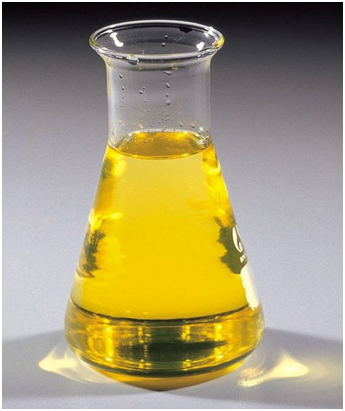
Most anionic surfactants including LABSA are nontoxic in nature. However, prolonged exposure to these surfactants, could irritate and damage the skin through the disruption of the lipid membrane, which protects the skin and other cells. On the other hand, the biodegradability is determined by surfactant's hydrophobic hydrocarbon group.
Most anionic surfactants including LABSA are nontoxic in nature. However, prolonged exposure to these surfactants, could irritate and damage the skin through the disruption of the lipid membrane, which protects the skin and other cells. On the other hand, the biodegradability is determined by surfactant's hydrophobic hydrocarbon group.
PARAMETER / TEST |
UNIT |
SPECIFICATIONS |
Appearance |
- |
Passes Test/Not Passes test |
Odour |
- |
Passes Test/Not Passes test |
Shelf Life (Fe) ppm Max. |
Month |
≤24 |
Anionic Active Matter |
% |
≥96.0 |
Molecular Weight distribution |
DA |
320 - 325 |
Free Oil / NDOM |
% |
≤2.0 |
Sulphuric Acid |
% |
≤1.5 |
Color |
Klett |
<40 |
Neutralization Value |
mg KOH/g |
≤190 |
Caustic Soda



Caustic Soda Flakes / Liq
Caustic soda flake , Sodium hydroxide (NaOH) an inorganic compound with following synonyms.
• Caustic soda • Caustic Soda Liquid • Sodium hydrate
caustic soda flake widely used inorganic industrial chemical. Sodium hydroxide is having certain properties like Sodium hydroxide’s chemical formula is NaOH NaOH molecular weight of 39.997 g/mol Sodium hydroxide is contain ph of ~12-14 Sodium hydroxide characteristics can be mentioned as
• Raw material for various industrial products • Co-product in chlorine synthesis • Strong base • Highly corrosive • Auxiliary chemical • Odorless material
Caustic soda is available in two forms – Caustic soda lye Caustic soda solid. Solid form of caustic soda can be in the form of Caustic soda flakes or Caustic soda granules Pure form of sodium hydroxide also available as Caustic soda has wide variety of industrial sectors like In pulp and paper processing industry caustic soda used at the stages like bleaching process, in de-inking of waste paper, and in water treatment. Next major industry like textile industry caustic soda is used to process cotton and synthetic fibers Caustic soda is utilized more in the soap and detergent industry. Other caustic soda uses include.
• In oil and gas industry – to remove pungent smells • In household cleaning products • In beverage bottles • In home soap making
Worldwide there is high demand for caustic soda and increase in caustic soda prices applications in daily lives this article gives the different modern caustic soda manufacturing processes. Sodium Hydroxide solutions. are produced by three different technologies
• Mercury cells • Membrane cells • Diaphragm cells
Each of above processes utilizes sodium chloride (NaCl) salt as the primary raw material. Electrolytic splitting of salt results in products like chlorine and sodium ion (Na+). In turn Na+ will react with water in the mercury cell to form Sodium hydroxide and Hydrogen as by product.
SLES
Sodium laureth sulfateis an anionic surfactant from the group of alkyl ether sulphates (INCI name: Sodium LaurethSulphate). The product is based mainly on raw material of natural origin. It has the consistency of a liquid paste, colourless to light yellow. The product is available in concentrated form as a 70% aqueous solution, which translates into a reduction in transport and storage costs. The product shows complete solubility even in hard water. It does not contain preservatives.
- high product purity and lack of preservatives
- increased resistance to hard water compared to other anionic surfactants, such as Sodium Lauryl Sulphate
- high product stability
- compatibility with other components of washing formulations
- synergism with amphoteric and non-ionic surfactants
- used in liquid detergent, such as dishware, shampoo, bubble bath and hand cleaner, etc
- In washing powder and detergent for heavy dirty, using it to partially replace LABSA, phosphate(STPP) can be saved or reduced, and general dosage of active matter is reduced
- In textile, printing and dyeing industry, petroleum and leather industry, it can be used as lubricant, dyeing agent, cleanser, foaming agent and degreasing agent.

Test Item |
Index |
Appearance |
white or light slime |
Active matter content % |
70+/-2 |
Unsulfated matter content %(contract to 100% active matter) |
3.0 max |
Inorganic sulfate content %contract to 100% active matter) |
2.0 max |
Color and Luster(5% A.M.Hazen) |
20 max |
PH value(1% AQ.Solution) |
7.0-9.5 |
Packing way |
170 kg/plastic drum |
Loading qty |
19.38 tons/20 FCL |
Lauric Acid
Lauric acid is the most abundant fatty acid present in coconut oil. It is also one of the main flavor constituents of Chinese rice wine and sweet cream butter. Lauric acid is commonly used in lubricants and also in edible-coating formulations.
Coconut oil is all the rage in natural beauty and health regimens. Countless blogs and natural health websites tout it as a miracle product, able to do everything from soothe cracked skin to reverse cavities.

However, when you break coconut oil down into its active parts, things start to look less miraculous and more like science.
Lauric acid is one of those active parts. It’s a medium-length long-chain fatty acid, or lipid, that makes up about half of the fatty acids within coconut oil.
The primary sources of lauric acid are:
- dietary supplements
- coconut oil — the highest natural source of lauric acid
- coconut cream, raw
- coconut cream, canned
- fresh shredded coconut
- coconut cream pudding
- coconut milk
- human breast milk
- cow and goat milk — containing small percentages of lauric acid
Isopropyl alcohol
(1) Isopropanol alcohol (IPA) is widely used in sterilization and disinfection(Coronavirus Disease 2019 (COVID-19)), deodorization and preservation, food preservation, water purification, air purification, isopropyl alcohol (IPA) is also widely used in liquid decontamination agents.
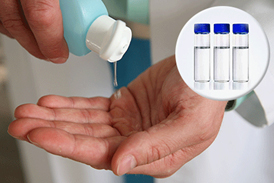

(2)Isopropyl alcohol (IPA) is mostly used for skin disinfection, hand disinfection, and disinfection of medical devices such as ophthalmoscopes, microscope eyepieces and objectives, ultrasonic probes, and stethoscopes.
(3)Isopropanol alcohol (IPA) has a wide range of uses as organic raw materials and solvents, and is used in pesticides, intermediates, coatings, inks, etc. In the electronics industry, IPA can be used as a cleaning and degreasing agent.
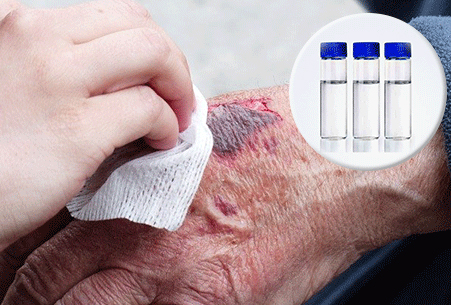
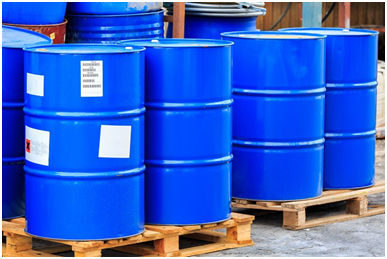
| Product Name | Isopropyl alcohol |
| Other Names | Isopropanol /2-PROPANOL/IPA |
| Purity | 99.9% |
| Type | Alcohol |
| CAS No. | 67-63-0 |
| Appearance | Colorless clarity liquid |
| Molecular Formula | C3H8O |
| Color (Pt-Co) | ≤10 |
| Content, % | ≥99.7 |
| Moisture, % | ≤0.10 |
| Acidity(CH3COOH), % | ≤0.002 |
| Evaporation residue, % | ≤0.002 |
| Carbonyl content (as Acetone), % | ≤0.02 |
| S, ppm | ≤2 |

Sodium Percarbonate – SPC
We are the Supplier of Sodium Percarbonate and it is a solid, environmentally friendly and highly stable bleaching agent, which combines the properties of hydrogen peroxide and sodium carbonate and provides an excellent bleaching and oxidizing performance as well as alkalinity. One of the remarkable features of spray granulated Sodium Percarbonate is its excellent storage stability, which is achieved by a sophisticated production process with a highly efficient coating.
Appearance |
White, odourless, free-flowing salt |
Characterization |
Addition compound of soda ash (Na2CO3) and hydrogen peroxide (H2O2) |
Formula |
Na2CO3*1.5 H2O2 |
Molecular mass |
157.03 g/mol |
pH 10g/l; 25°C |
10.5 |
Water solubility, g/l |
140 |
Parameter |
Unit |
Specification limits |
Active Oxygen |
% |
≥13.0 |
Bulk density |
g/l |
900 - 1200 |
Particle size
>1400 μm
< 150 μm
|
% |
≤ 10
≤ 5
|
TAM value (48h at 40°C) |
μW/g |
≤ 10 |
Moisture (IR; 60°C;) |
% |
≤ 0.5 |
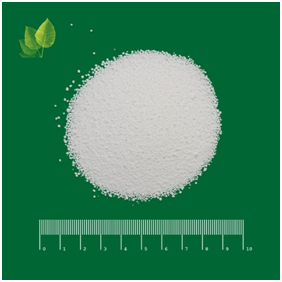
Sodium Percarbonateis used as a bleaching and oxidizing component in laundry powders and tablets, automatic dishwashing detergents, bleach boosters and denture cleaning agents. Due to its high bulk density, the product is ideally suited for compact formulations. Outside detergent applications it can be used as a source of alkaline hydrogen peroxide, for example, in fish farming, as an oxidizing agent in the textile industry or as a foaming agent (source of gaseous oxygen).
Store in cool, dry conditions in well sealed receptacles.
One Year from the date of manufacturing.
1000kg big bags, PE-lined 25kg paper bags.
Sodium Tripolyphosphate - STPP - Food & Technical Grade
SODIUM TRIPOLYPHOSPHATE or STPP is an inorganic compound. It is the sodium salt of the polyphosphate which is the conjugate base of triphosphoric acid. Sodium tripolyphosphateis produced by heating a stoichiometric mixture of disodium phosphate, Na2HPO4 and monosodium phosphate, NaH2PO4 under carefully controlled conditions.
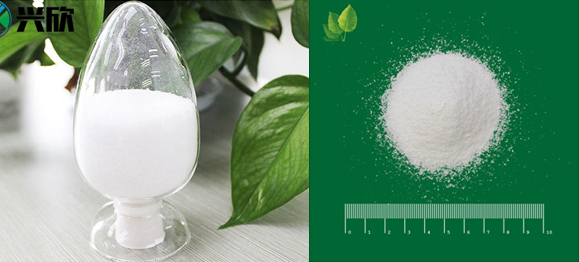
Stearic Acid Single Pressed - RGSA
Stearic acid is a saturated, straight chain fatty acid with an 18-carbon chain. It is derived from animal sources--typically tallow, and vegetable sources, such as palm stearin, which is ideal for use in natural formulations. We offer a range of stearic acids, varying by purity, iodine value, and titer options. Our broad portfolio contains EMERSOL® by Emery and Vantage’s VSTEARIN™, as well as a line of private label stearic acids in a variety of forms designed to meet the diverse, evolving needs of the marketplace. All grades are available throughout our wide distribution network, with fast, reliable service, and full documentation to support the precise certifications your business needs.
At room temperature, stearic acid is a waxy sold, mostly commonly sold as flakes, beads, or pastilles packaged in bags or supersacks. Manufacturers rely on stearic acid to enhance a variety of formulations, including lubricants and release agents, soaps, lotions, detergents, tire, rubber, candles, and crayons
The different stearic acid grades are available in liquid product form as well as flakes and sprayed prills that are easy to disperse and free-flowing.
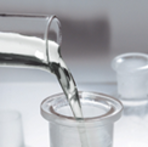
- dosage accuracy
- easy storage in tanks
- easy homogenisation in polymers and with other ingredients
- quick and safe flow through pumps
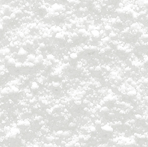
- very low dusting
- absolutely free flowing granules, compatible with powder blends
- very high bulk density
- high feeding accuracy
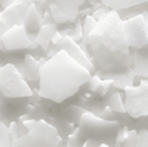
- absolute dust-free
- suitable to be stored in silo
- free flowing
- durable, high abrasion resistance
- improved industrial hygiene
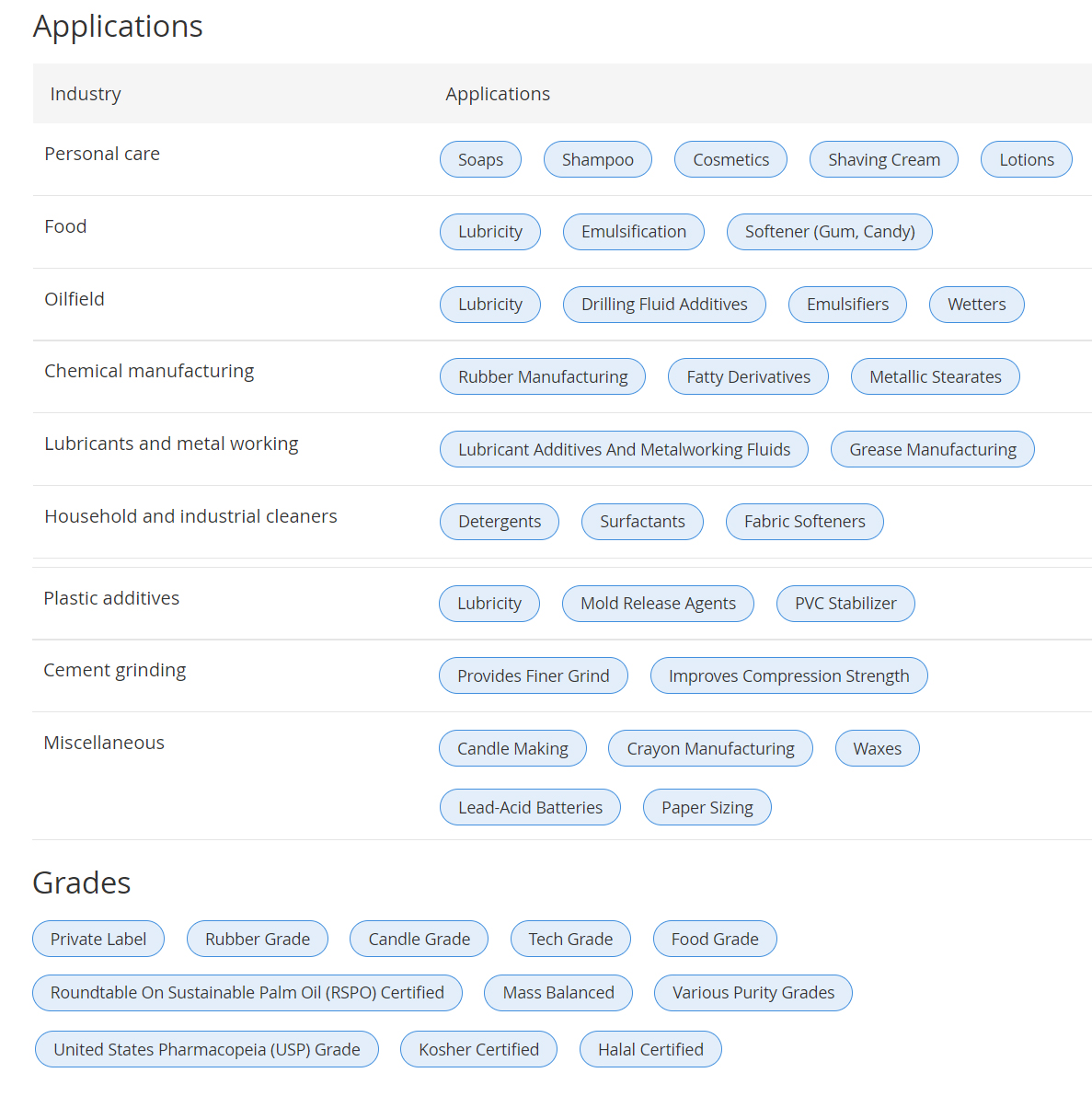
Sodium Bicabonate

A thousand opportunities to serve you
In 1863, Chem Color Intl discovered a new process for manufacturing sodium carbonate using sea salt, ammonia and carbonic acid.
This process produced a sodium bicarbonate of high purity,which is used today in many fields: food, detergents, health and remediation.
Overtime,the group has grown and now Chem Color Intl, with a presence in 55 countries on five continents, is the world leader in sodium carbonate and bicarbonatewith manufacturing plants in theUnited States and Europe.
Throughout this brochure, you will discover the amazing properties of Chem Color Intl bicarbonate and the numerous services this miraculous product can offer you every day.

From food to detergent, sodium bicarbonate is an all-purpose product with a thousand uses. you will find the most common uses, dosages and advice that will provide users with a simple, natural and effective practical help, for some everyday situations.
It contains only sodium bicarbonate, a white and extremely pure product. It is biodegradable and environmental friendly; it can be found in nature and plays a fundamental role in the human body. Its purity is a guarantee of its quality!

• Fruit and vegetables • Saucepans, kitchenware and cutlery • Delicate surfaces without scratching
In order to eliminate impurities, wax and other possible residues, do not forget to wash your fruit and vegetables with water and sodium bicarbonate before consumption.





Citric Acid
Citric Acid anhydrous product — is an odorless food additive with a tart, acidic taste. Our anhydrous citric acid is a translucent white crystal which is slightly hygroscopic and melts at 307°F.

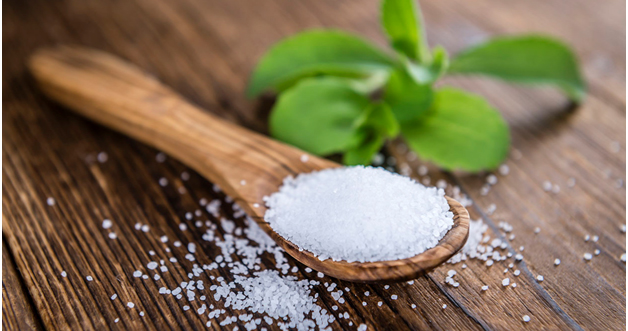
Citric acid is used in a broad array of applications, including foods and beverages (primarily as an acidulant, preservative and flavor enhancer), pharmaceuticals, household detergents and cosmetics.
ITEMS |
UNIT |
BP2007 |
USP30 |
HSCA |
|||
Description |
Colorless or White Crystailine Powder or granule |
||||||
Identification |
Pass |
Pass |
Pass |
||||
Clarity and color
of solution
|
Pass |
Pass |
Pass |
||||
Color of solution
|
Pass |
Pass |
Pass |
||||
Assay
|
% |
99.5-100.5 |
99.5-100.5 |
99.5-100.5 |
|||
Water
|
% |
≤1.0 |
≤1.0 |
≤0.5 |
|||
Aluminium
|
ppm |
≤0.2 |
≤0.2 |
≤0.2 |
|||
Heavy metals
|
ppm |
≤10 |
≤10 |
≤5 |
|||
Oxalic acid
|
ppm |
≤360 |
≤360 |
≤100 |
|||
Sulphates
|
ppm |
≤150 |
≤150 |
≤50 |
|||
Readily carbonizable substances
|
Pass |
Pass |
Pass |
||||
Sulphated ash
|
% |
≤0.1 |
≤0.1 |
≤0.05 |
|||
Bacterial endotoxins
|
I.U/mg |
≤0.5 |
Pass |
≤0.5 |
|||
Usage
1.For the food industry
Because citric acid has a mild and sour acidity, it is commonly used in the manufacture of various beverages, sodas, wines, candies, snacks, biscuits, canned juices, dairy products and the like. In the market of all organic acids, citric acid market share of more than 70%, flavoring agents, can also be used as antioxidants in edible oils. At the same time improve the sensory traits of food, enhance appetite and promote the digestion and absorption of calcium and phosphorus substances in the body. anhydrous citric acid is used in large quantities in solid beverages Salts of citric acid such as calcium citrate and ferric citrate are fortifiers that require the addition of calcium and iron ions in certain foods.
2.Used in the chemical and textile industries
Citric acid can be used as a chemical analysis reagent for chemical analysis, as an experimental reagent, a chromatographic reagent and a biochemical reagent; as a complexing agent and a masking agent; for preparing a buffer solution. The use of citric acid or citrate as a builder can improve the performance of the washing product, can quickly precipitate metal ions, prevent the re-attachment of contaminants on the fabric, maintain the necessary alkalinity for washing, and disperse and suspend the dirt and ash; Improves the performance of surfactants, is an excellent chelating agent; can be used as an acid-resistant reagent for testing architectural ceramic tiles.
3.For environmental protection
Citric acid-sodium citrate buffer is used for flue gas desulfurization.
4.For cosmetics
Citric acid is a kind of fruit acid. Its main function is to accelerate the renewal of keratin. It is often used in lotion, cream, shampoo, whitening products, anti-aging products, acne products. The renewal of keratin helps the exfoliation of melanin in the skin, the shrinkage of pores, the dissolution of blackheads, and the like.
Sodium Glutamate
Lorem Ipsum has been the industry's standard dummy text ever since the 1500s.
Tartaric Acid
Tartaric Acid is present in many fruits and the only use for industrial production is grapes. Our Tartaric Acid is a natural product that is derived from by-products of the grape. Our Tartaric Acid is a food grade product and it is Kosher certified. Used in many different applications due to its properties as: antioxidant, acidifier, flavor enhancer, stabilizer and sequestering agent. It is included in the list of FOOD ADDITIVES under code E-334
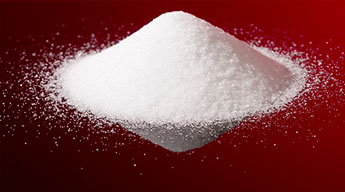
Item |
Specification |
Description |
Colorless crystals or white crystalline powder |
Content % |
99.7~100.5 |
Specific rotatory powder [a]D25℃[(°)•dm2kg-1] |
12.0~ 13.0 |
Loss on drying % |
≤0.5 |
Residue on ignition % |
≤0.05 |
Sulfate (SO4) |
Passes test |
Oxalate |
Passes test |
Lead mg/kg |
≤2 |
Food and Nutrition: Prizes tartaric acid as a well-known acidulant that has the ability to give food products a tart, sharp flavor. In addition, it acts as a preservative — plus, it can promote the setting of gelatin. Pharmaceutical Industry: It is a popular additive used to improve the flavors of various oral medications that are produced in effervescent tablet form. The acid’s derivative — tartar emetic — is employed as an expectorant in many cough syrups. In addition, the medical industry relies on tartaric acid when preparing solutions used to determine glucose — or blood sugar — levels. Plus, it is used in the production of Rochelle Salt — a known laxative. Textile and Dyeing: The tanning of leather goods, and the production of lacquers, as well as the fabrication of blue ink used in blueprints. Personal Care: Tartaric acid uses include anti-ageing creams & lotions, conditioners, cosmetics, facial cleaner, hair colorants and conditioner, moisturizing creams, and shampoo
L(+)-Tartaric acid Packaging and Shipping 25kgs per bag L(+)-Tartaric acid Storage dry cool place.
Glacial Acetic Acid 99.9%
Glacial acetic acid is a name for water-free ( anhydrous) acetic acid. Similar to the German name Eisessig ( ice vinegar ), the name comes from the ice-like crystals that form slightly below room temperature at 16.6 °C (61.9 °F) (the presence of 0.1% water lowers its melting point by 0.2 °C). 3COO− ), is thus represented as AcO−
Glacial Acetic acid Pure and it's a colorless liquid that absorbs water from the environment, and freezes at 16.7 °C to a colorless crystalline solid. It is a weak acid, and is known as Glacial because on freezing it forms needle shape crystals. It is a clear, colorless liquid with a pungent odor. It is the obtained by the destructive distillation of wood, by the oxidation of acetylene and water by air, and by the oxidation of ethyl alcohol by aerobic bacteria, as in the production of vinegar. Glacial acetic acid is strongly corrosive and potentially flammable, having a low flash point. Home vinegar is five percent by mass acetic. Dilute acid acetic in the form of vinegar has many home and culinary purposes.


Acetic Acid are primarily used in Pharmaceuticals, Agrochemicals, Textiles, Drugs and Dyes Industries.
• Dilute Acetic Acid is used as a preservative in the preparation of pickles
• Acetic Acids are used for making cellulose acetate which is an important artificial fibre
• Glacial Acetic Acid is used in the manufacture of acetone and esters used in perfumes
• Acetic Acid glacial is used in the preparation of dyes
Acetic Acid Glacial |
99.85 per cent min. by wt |
Water |
00.15% maximum |
Colour |
10 APHA maximum |
Formic Acid or Methanoic |
0.05 % maximum by wt |
Acetaldehyde |
0.05 per cent maximum by wt |
Heavy Metals as Pb |
Less than 2 ppm. |
Iodides |
40 ppb maximum. |
Permanganate |
2.00 hrs. minimum. |
Freezing Point |
16.4° C. |
Specific Gravity |
1.049 at 25° C |
CAS No |
64-19-7. |
UN No |
2789. |
Acetic Acid Uses
Acetic Anhydride |
Monochloro Acetic Acid |
Vinyl Acetate Monomer (VAM) |
Acetates |
Purified Terephthalic Acid (PTA) |
Diketene Derivatives |
Dyes and Dye Intermediates
• Acetic Acid is utilized in textile industries for textile processing and also printing.
• Acetic Acid Glacial is broadly used as a preservative in food industry.
In 30 kgs (Net). HDPE Carboys
Butyl Acetate
CAS: 123-86-4 N-Butyl Acetate is a chemical compound with a molecular formula of C6H12O2, CAS: 123-86-4. It is commonly used as a solvent in the production of lacquers, inks and adhesives. This product is a colourless liquid that has a fruity odour. This product is highly flammable with a flash point of 24° C. It is highly miscible with all common organic solvents (alcohols, ketones, glycols, esters) but has only slight miscibility in water.
Production
The most common method for creating n-butyl acetate is via the esterification of a butanol isomer and acetic acid which are heated in the presence of a strong acid.Uses
The most common use of normal butyl acetate is as a solvent in the production of lacquers and paints. Its other major use is in the creation of adhesives and hardened coatings. N-butyl acetate is also used in the pharmaceutical industry as a solvent or an extraction agent. Its minor uses include cosmetic products, fragrance solvent in perfumes, as an anti-corrosive agent, in cleaning and car care products. It is also used in the synthetic fruit flouring industry. Arpadis is one of the largest chemical distributor in Europe. Arpadis is handling the storage, transport, export & import formalities of N-Butyl Acetate globally.
Specifications
Grade |
Technical |
Form |
Liquid |
Spec. No |
PR/SBAC/18/05-02 |
Other Trade Name |
2-butyl acetate; 1-methylpropyl acetate |
CAS NO |
105-46-4 |
UN No |
1123 |
Chemical Formula |
C6H12O2 |
Molecular Weight |
116.16 |
Class |
3 |
Packing Group |
II |
Appearance |
clear colourless liquid |
Purity (%) |
99.0 min |
Sec-Butyl alcohol (%) |
0.05 max |
Moisture Content (%) |
0.1 max |
Acidity as acetic acid (%) |
0.01 max |
Color (Pt-Co) |
15 max |
Density at 20℃ (g/ml): |
0.860-0.878 |
Boiling range (℃) |
111-112 |
Evaporation residue (%) |
0.02 max |
Packing |
0.02 max |
Applications |
For manufacturing matchboxes, smoke devices, flares, as a fire retardant
Used to dope semiconductors
Used to legally produce methamphetamine
|
Safety and Handling |
Refer Safety Data Sheet |
Sodium Nitrate
Sodium nitrite, with chemical formula NaNO2, is used as a color fixative and preservative in meats and fish. When pure, it is a white to slight yellowish crystalline powder. It is very soluble in water and is hygroscopic. It is also slowly oxidized by oxygen in the air to sodium nitrate, NaNO3. The compound is a strong oxidizing agent.
It is also used in manufacturing diazo dyes, nitroso compounds, and other organic compounds; in dyeing and printing textile fabrics and bleaching fibers; in photography; as a laboratory reagent and a corrosion inhibitor; in metal coatings for phosphatizing and detinning; and in the manufacture of rubber chemicals. It may also be used as an electrolyte in electrochemical grinding manufacturing processes, typically diluted to about 10% concentration in water.
Sodium Nitrite SpecificationsTest |
Limits |
Appearance |
White to off-white crystalline powder |
Purity (On dry basis) by KMnO4 titration |
99.00 % w/w Min |
Loss on drying at 110ºC for 10 min |
0.50 % w/w Max |
Alkalinity as Na2CO3 or NaOH by H2SO4 titration - 0.20 % w/w Max |
|
Chloride as Cl by Nitrobenzene |
0.10 % w/w Max |
Sodium Nitrate by PDSA |
1.00 % w/w Max |
Water insoluble |
0.05 % w/w Max |
Sulphate as SO4 by turbidity |
0.08 % w/w Max |
Iron as Fe by Potassium thiocyanate |
0.002 % w/w Max |
Heavy metal as Pb by visual colourimetric |
0.005 % w/w Max |
Clarity of 30% aqueous solution |
It should be clear solution |
The material can also be offered with anti-caking agent.
Sodium Nitrite BP Pharmacopoeia
NaNO2
Action and use
Used in treatment of cyanide poisoning.
Content
98.5 per cent to 100.5 per cent (dried substance).
Appearance
Colourless crystals or mass or yellowish rods, hygroscopic.
Solubility
Freely soluble in water, soluble in alcohol.
A. Dilute 1 ml of solution S1 (see Tests) to 25 ml with water R. To 0.1 ml of the solution add 1 ml of sulphanilic acid solution. Allow to stand for 2-3 min. Add 1 ml of b-naphthol solution and 1 ml of dilute sodium hydroxide solution R. An intense red colour develops.
B. To 1 ml of the solution prepared for identification test A add 3 ml of a 20 g/l solution of phenazone and 0.4 ml of dilute sulphuric acid. An intense green colour develops.
C. To 0.15 ml of solution S1, add 0.35 ml of water R. The solution gives reaction of sodium.

Quality Standard
Test items | Quality Index | ||
High-class | First-class | Qualified | |
Appearance | White or yellowish crystals | ||
Sodium nitrite content (in dry basis) % | 99.0 | 98.5 | 98.0 |
Sodium nitrate content (in dry basis)% | 0.8 | 1.3 | / |
Chloride( NaCL)in dry basis % | 0.10 | 0.17 | / |
Moisture % | 1.4 | 2.0 | 2.5 |
Water insoluble matter content(in dry basis)% | 0.05 | 0.06 | 0.10 |
Degree of looseness (in terms of non-caking)% | 85 | ||
The product implementation standard is GB/T2367-2016 | |||
Package Delivery

Potassium Hydroxide
Potassium hydroxide is an inorganic compound used in a range of industrial applications. A strong base also known as caustic potash, its chemical formula is KOH, and its CAS number is 1310-58-3. Potassium hydroxide is highly corrosive. Though similar to sodium hydroxide, or NaOH, potassium hydroxide is produced in much smaller amounts and used less frequently in industry and manufacturing.
Synonyms: Caustic Potash, KOH, Potassium Hydroxide, Potassium Hydroxide Solution INCI: Potassium Hydroxide Chemical formula: KOH CAS #: 1310-58-3
Product |
Liquid Strength |
Grade |
Shipment Size (tonnes) |
Potassium Hydroxide |
50% |
Foodgrade |
15 -27 |
Potassium Hydroxide |
35% |
Foodgrade |
15 -27 |
Potassium Hydroxide |
30% |
Foodgrade |
15 -25 |
PRODUCT SPECIFICATIONS
Characteristics
Appearance |
Clear colorless viscous liquid |
Odor |
Odorless |
Boiling point |
271°F (132.8°C) |
Freezing point |
-22°F (-30.0°C) |
Molecular weight |
56.1 g/mol |
Weight per gallon |
12.1470 lb/gal |
Class |
Alkali, Caustic |
Grades |
Industrial, Technical, USP, NF grade |

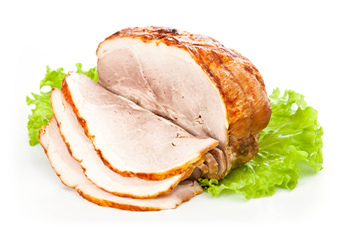
USES AND APPLICATIONS FOR POTASSIUM HYDROXIDE
• Agriculture (fertilizers, herbicides) • Food additives • Potassium carbonate • Alkaline batteries • Photo chemicals • Water treatment • Phosphates • Potassium chemicals • De-icing fluids • Soaps and detergents • Oil and gas drilling Potassium Hydroxide uses include absorption cartridge, acid neutralizer, batteries, buffer, coal treatment, cosmetics, dehydrating agent, detergents, drilling mud, fertilizer, fruit & vegetable peeling, gasoline, metal cleaners, petroleum, photographic, potassium carbonate, potassium phosphates, rubber. • Agriculture: It is used in the production of fertilizers. These fertilizer can be used as a source of potassium for crops that are sensitive to chloride ions • Rubber Industry: Potassium hydroxide solution was believed to be effective in reducing extractable protein content by leaching out the extractable protein from natural rubber latex films • Personal Care: It is used in small amounts in cosmetics to modulate the pH of a product. It's also used as a cleansing agent, most often in pure soaps or soap hybrid products. In higher concentrations, potassium hydroxide can aggravate skin, even if used in rinse-off products
Propylene Glycol
It is a light, transparent liquid, almost odorless and with low volatility. It is completely soluble in water and in most organic solvents. In addition, all propylene glycols have a great capacity to hold and dissolve active ingredients equally which allows them to serve as carriers of aromas, flavours, dyes and moisture.
Mono propylene glycol is utilized across many different industries and some chemical manufacturers produce two grades of MPG to meet these varied needs.
The first grade is used in the food, cosmetics, and pharmaceutical industries. MPG is used as a solvent for food colorings and flavorings. In the personal care industry, it is used as a moisturizer in make-up, shampoo, bubble bath and baby wipes, to name but a few examples. The pharmaceutical industry uses MPG as a solvent in oral, injectable, and topical formulations.
The main application for industrial grade MPG is as an antifreeze and aircraft wing and runway de-icer because the freezing point of MPG lowers upon mixing with water. It is also used in heat transfer liquids such as engine coolants.
It can also be used as a chemical intermediate in the production of high performance unsaturated polyester resins used in paints and varnishes. It is also an excellent solvent that is utilised in printing inks and it is also used in the manufacture of detergents which are used in the petroleum, sugar-refining, and paper making industries.

• High quality products • Excellent logistic service • Technical service and developmen
Propylene glycol USP/EP for foodPropylene glycol USP/EP (pharmaceutical grade) is the only grade appropriate for application in food. As propylene glycol USP/EP is colour-, taste- and odorless, it has become the perfect carrier of flavours of a wide variety of food commonly used in our day a day. Propylene glycol USP/EP (pharmaceutical grade) is approved for use as a food additive under E-number E 1520 (with strict maximum limit of 1 g/kg in human foodstuffs). Direct food contact uses include: • Carrier of colorants, emulsifiers and antioxidants with a maximum allowed level of 1,000 mg/kg in the final food. • Carrier in food enzymes with a maximum permitted level of 500 g/kg of enzymes. • Carrier of food aromas. • Carrier of nutrients with a maximum allowed level of 1,000 mg/kg in the final food. Propylene glycol USP/EP (pharmaceutical grade) is also used in animal feed because of its inherent property of attracting water, helping to keep the feedstuffs moist, fresh and chewy, making them easier to digest for our dogs and also for livestock. In 2010, propylene glycol was reclassified as an animal feed material according to EU Regulation 767/2009/EC, repealing the previous list as a feed additive with the number E-490. Applications of propylene glycol USP/EP as feed ingredient include its use as: • Humectant to provide moisture and taste • Solvent, stabilizer and preservative to keep the feed suitable for longer use • Additive for increased energy provision Propylene glycol for cosmetic and personal care • The products from Repsol’s Chemicals Division are used to manufacture everyday articles which improve people’s quality of life, well-being and safety. • MPG Monopropylene glycol USP/EP is widely used in creams for their excellent properties
Sodium Acid Pyrophosphate - SAPP 95% 200 Mesh - Food Grade
Sodium acid pyrophosphate is an inorganic compound consisting of sodium cations and pyrophosphate anion. It is a white,water-soluble solid that serves as a buffering and chelating agent, with many applications in the food industry.
ITEM |
STANDARD |
Na2H2P2O7 |
95.0% MIN |
APPEARANCE |
WHITE POWDER |
WATER INSOLUBLE |
1.0% MAX |
ARSENIC( AS) |
3PPM MAX |
LOSS ON DRYING |
0.5% MAX |
CADMIUM (PPM) |
1 MAX |
LEAD (PPM) |
4 MAX |
MERCURY (PPM) |
1 MAX |
HEAVY METAL( PB) |
15PPM MAX |
FLUORID( PPM) |
10 MAX |
PH VALUE |
3.5-4.5 |

White powder or granular;Relative density 1.86g/cm3;Soluble in water and insoluble in ethanol; If its aqueous solution is heated together with diluted inorganic acid, it will be hydrolyzed into Phosphoric Acid; It is hydroscopic, and when absorbing humidity it will become into a product with hexa-hydrates; If it is heated at a temperature above 220℃, it will be decomposed into sodium meta phosphate. As a leavening agent it is applied to roast foodstuffs to control the fermentation speed; When applied to instant noodles, it can shorten water resetting time and avoid stickiness and mushiness of the noodles; When applied to crackers or cakes, it may shorten fermentation time, lower the breakage, make the porous space in good order and therefore lengthen the shelf life.
Uses • Fast reacting leavening agent. • Component of baking powder and self- rising flour.
Packaging • 25 Kg or 50 Lbs. multi-walls PE lined paper bags on pallets • 1000 Kg or 2205 Lbs. Big Bags.
Sodium Metabisulphite
Our Principal factory is in Changsha . Xian Wang chemicals was founded in 1996 in Changsha, Annual production capacity up to 50,000 tons for sodium metabisulfite.
Our company relies on strong technical force and advanced process equipment to supply high-quality products and competitive price to the customers.We persist the attitude of sincere cooperation and micro-service.The Plant is equipped with a full-time quality control system and the quantity of quality control has been reached to 10 persons,meanwhile, we bring in the advanced testing and monitoring methods to guarantee the superior products.
We adhere to the quality policy--"standardized management, quality first; customer first, continuous improvement"."Quality first is our eternal theme, Quality service is our sacred duty, Customer satisfaction is our pursuit."quality goals , create first-class "HaoLin" brand.

ITEMS |
UNIT |
SPECIFICATION |
Purity |
(%)min |
97 |
As |
(ppm) max |
2 |
Fe |
(ppm) max |
30 |
Pb |
(ppm) max |
5 |
Cd |
(ppm) max |
5 |
PH |
4-5 |
|
Water insolubles |
(%)max |
0.03 |
Usage
it is for printing and dyeing industry, organic synthesis, printing, leather, pharmaceutical and other sectors; in food processing as preservatives, bleaching agents, baking powder.And used in industrial mineral processing.
PackingNet 25kgs woven bags with inner liner.
StorageSealed in cool and dry place.

Sodium Hexametaphosphate
Sodium Hexametaphosphate (SHMP), the white crystalline powder in appearance, is an inorganic substance with the molecular formula (NaPO3)6. It is very soluble in water but insoluble in organic solvents. It is highly hygroscopic, and it can gradually absorb moisture when exposed to the air and become a viscous gel. Of course, the most important thing is that SHMP has a wide range of applications in the industrial and food fields. For example, SHMP chemical can be used for soap, detergents, water treatment, metal finishing and plating, pulp and paper manufacture, synthesis of polymers, photographic products, textiles, scale removal and food additives, etc.
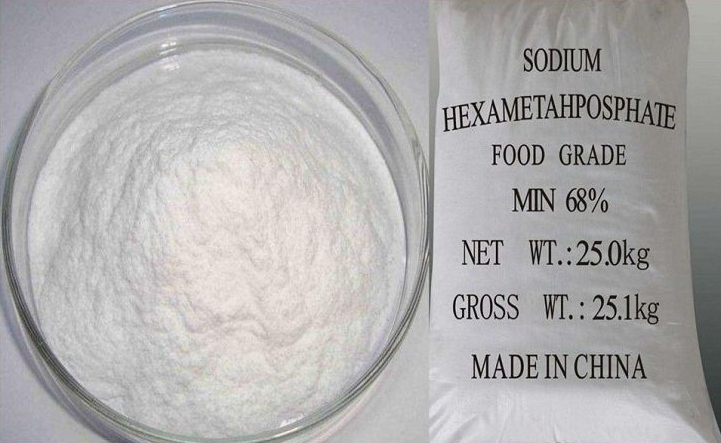
As a professional SHMP manufacturer and supplier, Fengbai always provides high-quality SHMP chemical and factory sales prices for all the customers. Please check the specifications below and contact us online at any time!
Item |
SHMP Industrial Grade |
SHMP Food Grade |
||
Total phosphate, as P2O5 % ≥ |
68.0 |
68.0 |
||
Inactive phosphate, as P2O5 % ≤ |
7.5 |
7.5 |
||
Iron, as Fe % ≤ |
0.03 |
0.02 |
||
Ph value (1% solution) % ≤ |
5.8-7.0 |
5.8-6.5 |
||
Water insoluble % ≤ |
0.04 |
0.05 |
||
Heavy metals, as Pb % ≤ |
— |
0.001 |
||
Arsenic, as As % ≤ |
- |
0.0003 |
||
Fluoride as F % ≤ |
— |
0.003 |
||
Package |
Plastic-woven sack with polythene inner bag, net weight 25kg,50kg or 1000kg. |
|||
Storage |
Keep away from water or moisture, do not pile up the open air. |
|||
Uses of Sodium Hexametaphosphate 68%
SHMP Industrial Grade. It is widely used in oil field, paper-making, textile, printing and dyeing, petrochemical, tanning, boiler, metallurgical industry and building material industries, so it can be used as water softener, buffering agents, flotation agent and high temperature binding agent. SHMP Food Grade. SHMP can be used as additive agent, nutrients, quality improver, PH value adjustment agent, metal ion chelating agents, binders, extenders,etc.Benzoic acid
The production of phenol is the most common use for Benzoic Acid. In the synthesis of some other organic chemicals, Benzoic Acid is often used as an intermediate. The salts of Benzoic Acid can also be used as a food preservative. Benzoic Acid is a precursor to glycol benzoates and other benzoate based plasticizers. Benzoic Acid occurs naturally in animals, plants, and resins, and it can be used as a natural topical antiseptic in some products. Benzoic Acid can also be used in inhalant decongestants. Benzoic Acid can be used in the production of sodium salt, as well as an intermediate in the synthesis of alkyd resins. Benzoic Acid also may be used as an additive to drilling mud for crude oil. Benzoic Acid is also used as a preservative which increases storage stability and inhibits corrosion of emulsions, polishes, waxes, paints and liquid detergents. In rubber polymerization, Benzoic Acid can be used as an activator. Benzoic acid can also be used as a modifier to flame retardant materials.

Production Data
Items |
Index |
Content |
98-100.5% |
Loss on drying |
≤0.5% after drying for three hours over sulphuric acid |
Melting range |
121.5-123.5°C |
PH |
About 4 (solution in water) |
Arsenic |
≤3 ppm |
Lead |
≤5 ppm |
Mercury |
≤1 ppm |
Heavy metal (as pb) |
≤10 ppm |
Sulphated ash |
≤0.05% |
Positive sublimation test and test for benzoate |
Qualified with regulations |
Readily oxidizable substances |
Qualified with regulations |
Polycyclic acid |
Pass test |
Chlorinated organic compounds |
≤300 ppm |
Appearance of solution |
Clarification, colorless |
Shelf life |
2 years |
Use of Benzoic Acid:
1. Use as a precursor to plasticizer:
Benzoic Acid is the ingredient needed in the production of Benzoate and Dibenzoate plasticizers. These plasticizers are mainly used in flooring, film, adhesives, and sealants.
Typical Benzoate plasticizers include Isodecyl Benzoate (IDB) and Isononyl Benzoate (INB). Common Dibenzoate plasticizers include Dipropylene Glycol Dibenzoate and NeopentylglycolDibenzoate.
Although Phthalate plasticizers have been the most commonly used plasticizers in past decades, non-Phthalate plasticizers such as the Benzoates have been on the rise in recent years as regulatory bodies around the globe have come to realize the potential danger of Phthalates to human health.
2. Benzoic acid use as a feed additive:
Pig farmers around the globe have been relying on Zinc Oxide to counter piglets’ Post-Weaning Diarrhea (PWD) for decades. Yet Zinc Oxide’s use has been restricted in recent years due to its severe environmental repercussions.
In face of the coming ban of Zinc Oxide in EU, and the growing restriction on its use globally, feed additive manufacturers have turned to Benzoic acid as an alternative,
either administered directly or applied with slow-releasing coatings, is effective in the prevention and mitigation of PWD.
It poses no harm to the environment due to its organic nature. Benzoic acid can also accelerate piglets’ fattening process.
3.Use as a Food Preservative and a Precursor to other Benzoic Salt Preservatives:
Benzoic acid is a powerful anti-septic agent widely used in food and animal feed. However, due to its poor solubility, it is often more preferable to use its salts instead. Its Sodium salt, Calcium salt, and Potassium salt are among the most common food preservatives in the modern food industry.
Benzoic Acid Specification:
Appearance
White Crystalline Powder with Various Particle Sizes for Various Purposes:
a.10-20 Mesh Flake
b.40-60 Mesh Coarse Powder
c.60-80 Mesh Standard Powder
d.80-150 Mesh Fine Powder
e.200+ Mesh Ultra-Fine Powder
CAS Number: 65-85-0
EINECS:200-838-9
Formula: C7H6O2
Molar Mass: 122.12 g/mol
Structure:
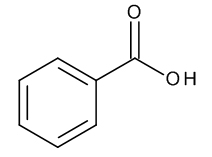
Solubility
It is easily soluble in alcohol, ether, and benzene, but poorly soluble in water (0.3 g of benzoic acid in 100 g of water at 20 °C).
Melting Point : 76°C – 76.5°C
Boiling Point: 249.3°C±9.0°C
Flash Point: 111.4±13.4°C
Density g/ml: 1.27 g/cm3
Molecular Weight Of Benzoic Acid: 122.12 g/mol
Remarks
We supply Benzoic acid fit for feed/food uses in flexible particle sizes. We also supply coated Benzoic acid specialized in swine feed additive. Please contact us for product TSD, typical CoA, and MSDS.
If any need, welcome ask us freely.
CMC
Sodium carboxymethyl cellulose (CMC/cellulose gum) is a kind of cellulose ether, can easily soluble in cold and hot water, with maximum yield, most widely and conveniently used among all cellulose products. The main raw material of CMC is refined cotton and wood pulp. It is mostly used in the food industry with a common dosage of 0.2%-0.5%. Compared with other similar hydrocolloids, food-grade CMC is featured by strong acid resistance, high salt-resistance and good transparency, with very few free fibers, fast dissolving and good fluidity after dissolving.
The main function of carboxymethyl cellulose is a thickener, stabilizer, tenacity strengthening agent, water retention agent, dispersing agent, binder, suspension, film-forming agent and so on in food and beverage processing, such as ice cream, juice, fruit jam, dairy products, beer, lactic acid drinks, yogurt, syrups, bakery products, wine, sauces, seasoning, meat products, etc.
Food grade CMC can control the size of crystal in frozen food, prevent stratification between oil and water. In an acid system, it has good suspension stability in acid-resistant food, can effectively improve solution stability and impedance capability of protein. Sodium carboxymethyl cellulose can improve taste and mouthfeel, reduce the syneresis of food, raise quality and prolong shelf life.
Used as a food additive, the main function of food-grade CMC is as thickener, stabilizer, tenacity water retention agent, emulsifier, suspension, film-forming agent and so on. It can be applied in various food, like ice cream, juice, fruit jam, dairy products, beer, lactic acid drinks, yogurt, syrups, bakery products, wine, sauces, seasoning, meat products, etc.
1. Thickening and Taste Improvement Effect
Food grade CMC can produce higher viscosity at low concentrations, endow smooth texture to food. The pseudo-plasticity effect of CMC brings refreshful and strong taste. Its good suspension stabilizing characters can make food keep the uniformity on odor, concentration, and taste.
2. Structure Loosen Effect
Good rheological and gel stable characteristics of food-grade CMC can prevent dehydration and shrinkage of food, can improve the expansivity rate of food. Reversibility between viscosity and temperature of CMC is good for the increase of food expansivity rate.
3. Suspending Effect
Sodium carboxymethyl cellulose can be used as a suspending agent in different food. Have a good suspension bearing capacity. If mixing with agar, guar gum, etc, will get good compatibleness and tenacity strengthening the effect.
4. Water Retention Effect
Food grade CMC (thickener e466) has good hydrophile and rehydration properties. It can reduce dehydration and shrinkage of food, prolong storage time. Water-holding property is applied to prevent water evaporation or non-crystallization of sugar.
5. Binding Effect
Food grade CMC can produce higher viscosity at low concentrations, endow smooth texture to food. The pseudo-plasticity effect of CMC brings refreshful and strong taste. Its good suspension stabilizing characters can make food keep the uniformity on odor, concentration, and taste.

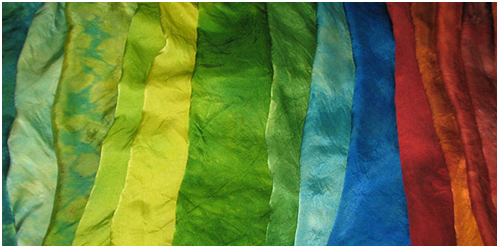
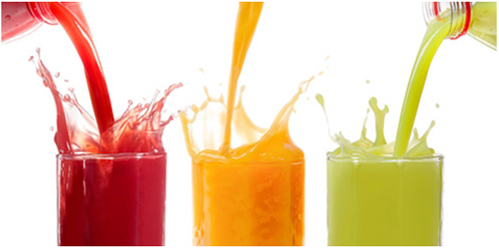

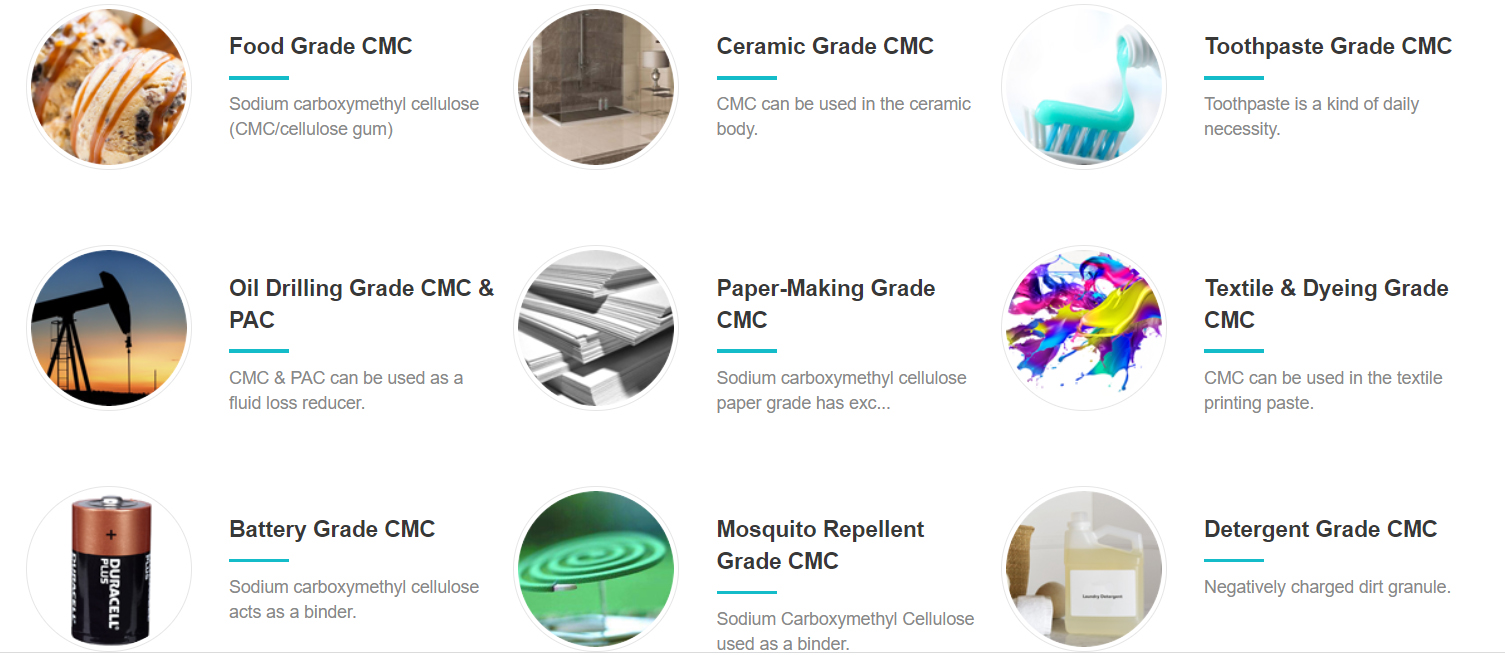
Lactic acid
Lactic acid is an organic acid occurring naturally in the human body and in fermented foods. It is used in a wide range of food, beverages, personal care, healthcare, cleaners, feed & pet food and chemical products as a mild acidity regulator with flavour enhancing and antibacterial properties. The commercial production of lactic acid is typically done by fermentation. Because the L(+) form is preferred for its better metabolisation, Jungbunzlauer has chosen to produce pure L(+)-lactic acid by traditional fermentation of natural carbohydrates. JungbunzlauerL(+)-lactic acid is a colourless to yellowish, nearly odourless, syrupy liquid with a mild acid taste. It is commercially available as aqueous solutions of various concentrations. These solutions are stable under normal storage conditions. Lactic acid is non-toxic to humans and the environment, but concentrated solutions of lactic acid can cause skin irritation and eye damage. They have thus to be labelled with a hazard pictogram and related statements. Lactic acid is readily biodegradable.
General Characteristics
• Appearance: Clear, colorless to light yellow solution • Chemical Formula: C3H6O3 • Molecular Weight: 90.08 • CAS#: 79-33-4 (General: 50-21-5) • Shelf Life: 1,095 days • Storage Recommendation: 55 – 95° F

Component |
Specification |
Lactic Acid, wt. % |
87.1 – 92.4 |
Identification, Lactate |
Passes Test |
Chloride, wt.% |
≤ 0.1 |
Cyanide, ppm |
≤ 5 |
Iron, ppm |
≤ 10 |
Lead, ppm |
≤ 0.5 |
Sulfate, wt. % |
≤ 0.25 |
Sugars/div> |
Passes Test |
Citric, Oxalic, Phosphoric, or Tartaric Acid |
Passes Test |
Residue on Ignition (Sulfated Ash), wt. % |
≤ 0.1 |
Isomeric Purity |
≥ 95% L (+) |
Water |
Balance |
Xanthan Gum
Xanthan gum is a polysaccharide widely used for its unique ability to control the rheological properties of a wide range of food products. Xanthan gum dissolves readily in hot or cold water, provides uniform brine distribution, is stable in acidic and alkaline solutions and has synergistic interactions with other hydrocolloids such as locust bean gum and guar gum. Xanthan gum creates a pleasant texture in foods and beverages. As an ingredient in beverages, xanthan gum can produce an increase in the viscosity of a liquid. In foods like dressings and sauces, xanthan gum helps to prevent oil separation by stabilizing the emulsion. Xanthan gum as an ingredient in ice cream and other frozen foods, produces desired texture. Xanthan gum produced by Cargill Texturizing Solutions complies with all legal, religious and safety requirements, and can be supplied and certified free of any genetically modified organism (GMO).

Applications
Bakery: Bakery & Pastry (bread type products, cake type products) Beverages: Alcoholic Convenience Foods: Sauces and Dressings (emulsified sauces, tomato-based sauces, sauces with particles in suspension, dry mix sauces) Dairy: Ice Creams and Dairy Products, Powder Products Fruits & Vegetables: Fruit Preparations Meat & Fish
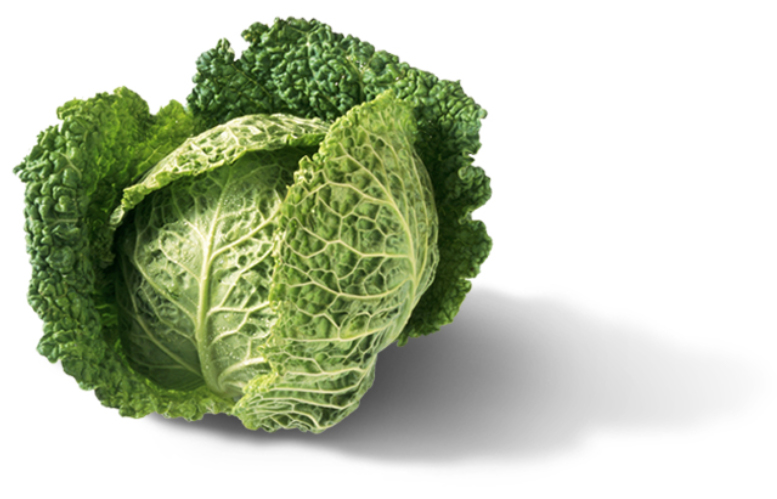
Functionality Xanthan gum is a biopolymer
Xanthan gum is produced as a secondary metabolite by a fermentation process, based on the culture, in aerobic conditions, of the micro-organism Xanthomonascampestris. Xanthan gum is a hetero-polysaccharide with a very high molecular weight (between one and several million). Its main chain is composed of glucose units. The side chain is a trisaccharide, consisting of alpha-D-mannose that contains an acetyl group, beta-D-glucuronic acid, and a terminal beta-D-mannose unit linked with a pyruvate group. The monosaccharides present in xanthan gum are: beta-D-glucose, alpha-D-mannose and alpha-D-glucoronic acid in a ratio of 2:2:1. The beta-D-glucoses are (1->4) linked to form the backbone. Alternate glucoses have a short, three-sugar branch consisting of a glucuronic acid sandwiched between two mannose units. Thus, the overall repeating structure is the pentasaccharide.
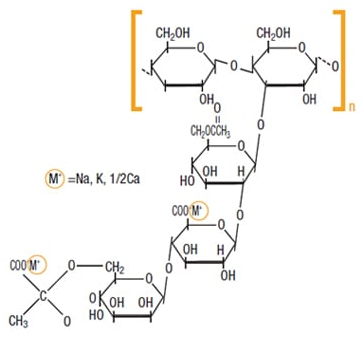
The terminal mannose can have a pyruvate group attached and the mannose adjacent to the main chain may have an acetyl group attached to C6. In general, about one branch in two has a pyruvate group, but the ratio of pyruvate to acetate varies depending on the substrain of Xanthomonascampestris used and the conditions of fermentation. The glucuronic and pyruvic acid groups give xanthan gum a highly negative charge. These acid groups are neutralized using sodium, potassium or calcium ions for food products. In their solid state xanthan gum molecules have a helical structure. The branches fold in, to lie along the backbone. Xanthan gum is a thickening agent. Its rigid helical structure can be melted, leading to a disorganized state with lower viscosity. The organized state is stabilized by the presence of electrolytes. The transition temperature is above 100° C in the presence of small quantities of salt. The presence of anionic side chains on the xanthan gum molecules enhances hydration and makes xanthan gum soluble in cold water. Xanthan gum is one of the most successful hydrocolloids due to its unique functionality, particularly in difficult environments like acid, high salt and high shear stress.
Temperature and acid stability
Solutions of xanthan gum are generally not affected by changes in pH value. Xanthan gum will dissolve in most acids or bases.
Viscosity control
The viscosity of xanthan gum is stable at low pH values and at high temperatures for a long period of time.
Salt tolerance
Viscosity is not affected by the addition of large amounts of salt; for example, in a 250 liter sodium chloride brine, only a slight increase in viscosity can be observed.
Freeze/thaw stability
Thanks to its water binding capacity, xanthan gum solutions exhibit good freeze/thaw stability.
Compatibilities
Xanthan gum is cold soluble, providing high viscosity and pseudoplastic behavior at low concentration. It can be directly dispersed in oil or a sugar solution to avoid introduction of air bubbles in water or when water is not directly available in the formulation. Dissolution takes place during processing. In order to facilitate handling, dust-free and granulated versions assist dispersion or dissolution needs. Xanthan gum has a synergistic effect in combination with locust bean gum and konjac (gel formation) as well as with guar gum (higher viscosity). Thanks to the unique rheological and synergistic properties of its aqueous solutions, xanthan gum is used in many applications as a suspending agent and emulsion stabilizer, a foam enhancer or an improver of dough volume.
Sodium Formate
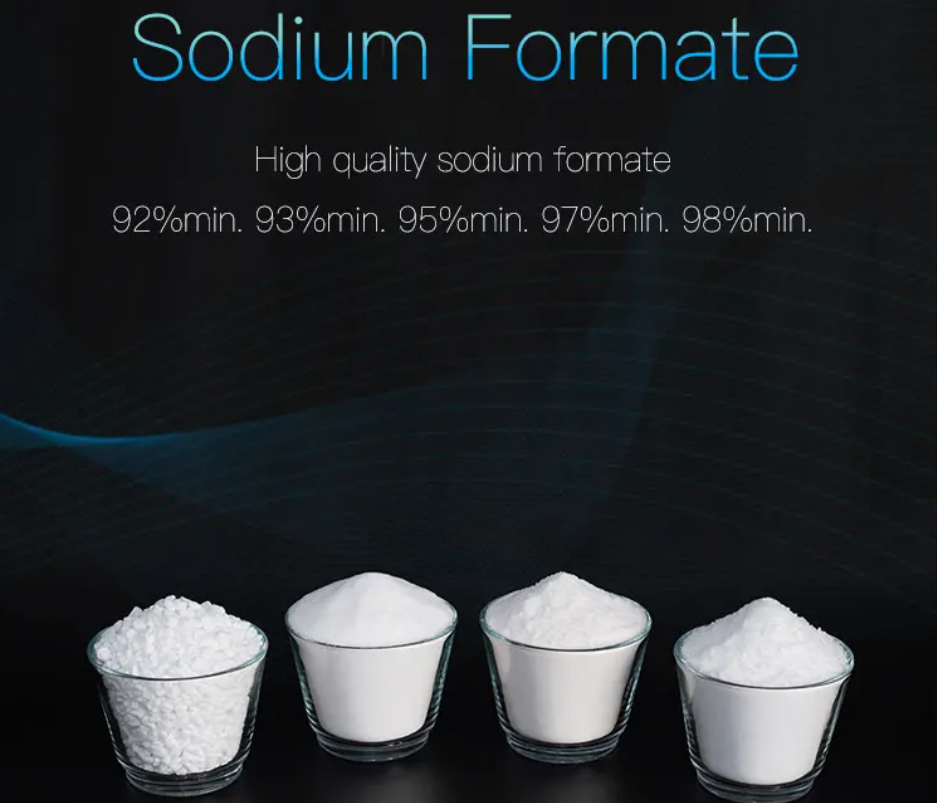
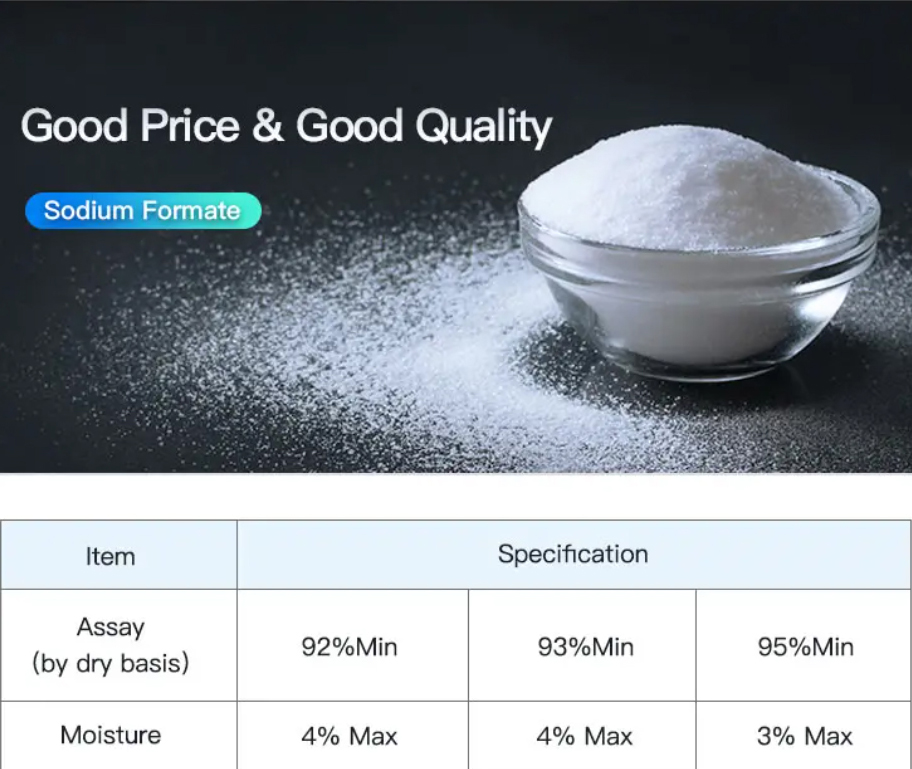
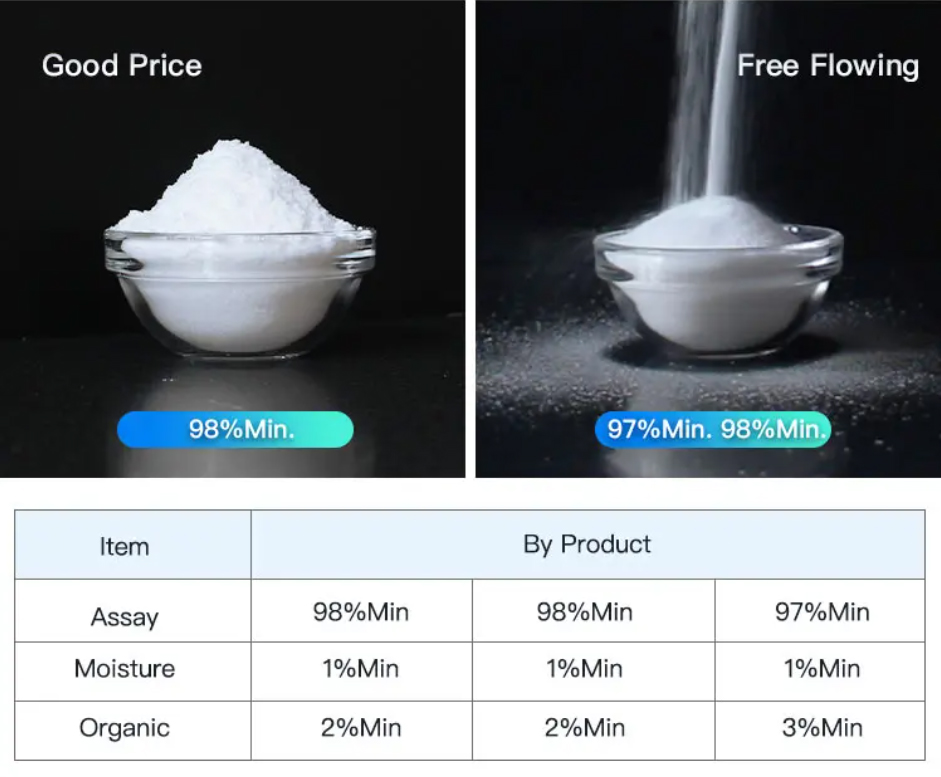

Formic Acid
Formic acid is a colourless, fuming liquid with a pungent odour; it irritates the mucous membranes and blisters the skin. It freezes at 8.4 °C (47.1 °F) and boils at 100.7 °C (213.3 °F).
Formic acid is widely used in diversified industries all over the world. In medical industry it is used in making Amidopyrin, Vitamin B and many other medicines. In chemical industry, Formic Acid is used in the production of methanamide, diethyl formamide, rubber age resister, dying and so on. It is also an important material for pesticide, such as Triazone. Besides, formic acid is also commonly used in silage.
ITEMS |
VALUE |
Color(pt-co) |
5 MAX |
chloride(cl) |
0.0005% MAX |
Sulphate (SO4) |
0.0005%MAX |
Iron ( Fe ) |
0.0001%MAX |
Evaporation residue |
0.004 %MAX |
Formic Acid is used in textile processing to control the pH of waste-water
(neutralization of the pH and the excess NaOH from manufacturing process).
Formic acid is used in several steps of leather processing. Methods for processing leather involve steps of preparing skins for tanning, optionally dyeing the leather and finishing if required.
One of the traditional uses of formic acid is the coagulation of natural rubber, which is produced primarily in south-east Asia. Latex milk is tapped from rubber trees and is mixed with formic acid to produce the coagulated rubber that is further processed into tires and numerous other rubber products.
- Households: descaling, and cleaning of bathroom surfaces
- Industrial cleaning: cleaning and descaling of equipment and tanks (e.g., in breweries), corrosion removal
- Others: wine casks, dairies
- Feed & drinking water: In animal feed additives, formic acid is used as a growth promoter; it acts positively on the gut flora of animals (poultry, swine, and cattle), improves feed efficiency and average daily weight gain, and reduces pathogen-caused diseases in the intestines
- Preservation & acidification of feed mixes: Formic acid has antibacterial effects, which are used to preserve and acidify feeds. Organic acids, including formic are often blended in mixtures for use as alternatives to antibiotics
- Grass silage: Prevention of bacteria and mold (lower activity than propionic acid) growth avoids spoilage in open storage structures
- Fish Silage: Formic Acid helps helps to speed up of break down of fish proteins while preventing bacterial spoilage
- Agricultural Biocides
- Flue Gas desulfurization
- Pretreatment for the conversion of sugarcane bagasse to bioethanol
- Wood adhesive
- Paper Industry
- Steep Pickling
- Paint Remover
- Process Chemical (e.g. adjustment of pH)
- Epoxidation of soybean oils: Plasticizers
- Fuell Cell
Sodium Sulphide Flakes
Name |
Sodium Sulphide (Na2S) Red Flakes |
Color |
Red Flakes |
Packing |
25kds/bag woven plastic bag or 150kgs /iron drums |
Model |
50PPM |
80PPM |
150PPM |
1500PPM |
Na2S |
60% min |
60% min |
60% min |
60% min |
Na2CO3 |
2.0% max |
2.0% max |
3.0% max |
5.0% max |
Water Insoluble |
0.2% max |
0.2% max |
0.2% max |
0.4% max |
Fe |
0.005% max |
0.008% max |
0.015% max |
0.15% max |
Molecular Formula
Na2S Molecular Weight: 78.04 Standard: GB/T10500-2000
NatureYellow or red flakes, strong moisture absorption, soluble in water, and water solution is strongly alkaline reaction. Sodium sulphide will cause burns when is touched with the skin and hair. The method of solution in the air will slowly oxygen.
Sodium thiosulfate, sodium sulfite, sodium sulphide and sodium polysulfide, because sodium thiosulfate’s generating speed is faster, its major product is sodium thiosulfate. Sodium sulphide is deliquesced in the air and carbonated so that it is metamorphic, and constantly release hydrogen sulfide gas. The industrial sodium sulphide includes impurities, so its color is red. Specific gravity and boiling point are influenced by impurities.
sodium sulphideis used to produce vulcanization dye, sulphur cyan, sulphur blue, dye intermediates reductance, and other nonferrous metallurgy industry used for ore flotation agents. Sodium sulphide can also make the depilatory cream in the leather industry. It is cooking agent in the paper industry. Meanwhile, sodium sulphideis also used to produce Sodium thiosulfate, sodium sulfite and sodium polysulfide.
Name |
Sodium Sulphide Yellow Flakes (Na2S) |
Color |
Yellow Flakes |
Packing |
25kds/bag woven plastic bag or 150kgs /iron drums |
Model |
10PPM |
15PPM |
20PPM |
30PPM |
Na2S |
60% min |
60% min |
60% min |
60% min |
Na2CO3 |
2.0% max |
2.0% max |
2.0% max |
2.0% max |
Water Insoluble |
0.2% max |
0.2% max |
0.2% max |
0.4% max |
Fe |
0.001% max |
0015% max |
0.002% max |
0.003% max |
Molecular Formula
Na2S Molecular Weight: 78.04 Standard: GB/T10500-2000
NatureYellow or red flakes, strong moisture absorption, soluble in water, and water solution is strongly alkaline reaction. Sodium sulphide will cause burns when is touched with the skin and hair. The method of solution in the air will slowly oxygen.
Sodium thiosulfate, sodium sulfite, sodium sulphide and sodium polysulfide, because sodium thiosulfate’s generating speed is faster, its major product is sodium thiosulfate. Sodium sulphide is deliquesced in the air and carbonated so that it is metamorphic, and constantly release hydrogen sulfide gas. The industrial sodium sulphide includes impurities, so its color is red. Specific gravity and boiling point are influenced by impurities.
sodium sulphideis used to produce vulcanization dye, sulphur cyan, sulphur blue, dye intermediates reductance, and other nonferrous metallurgy industry used for ore flotation agents. Sodium sulphide can also make the depilatory cream in the leather industry. It is cooking agent in the paper industry. Meanwhile, sodium sulphideis also used to produce Sodium thiosulfate, sodium sulfite and sodium polysulfide.
Package
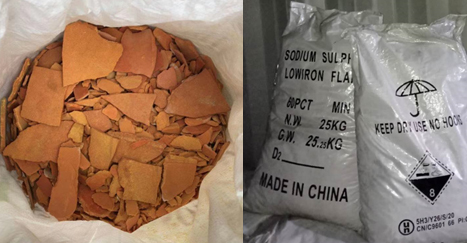
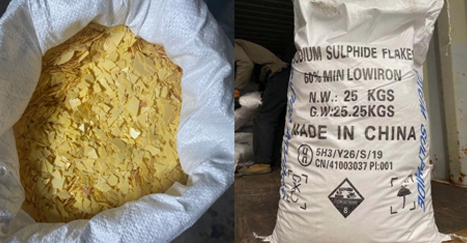
Chromium Sulphate
Basic chromium sulfate is an inorganic compound with the chemical formula Cr(OH)(SO4). It is a green, odorless solid at room temperature. It is typically sold in powder form. Basic chromium sulfate has high tanning power and hence largely used in the tanning of leather. It is easily soluble in cold water and very soluble in hot water. Chromium, particularly in the hexavalent oxidation state, is toxic, hence basic chromium sulfate, which is comparatively less toxic, is preferred in the leather industry.
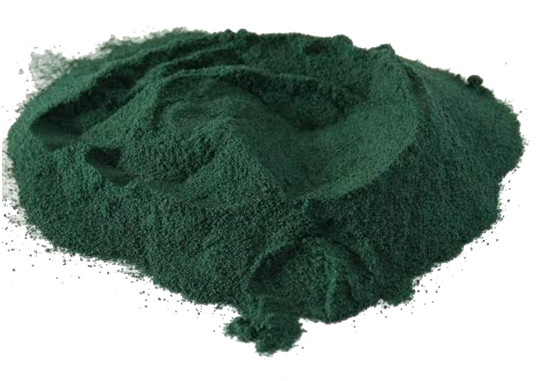
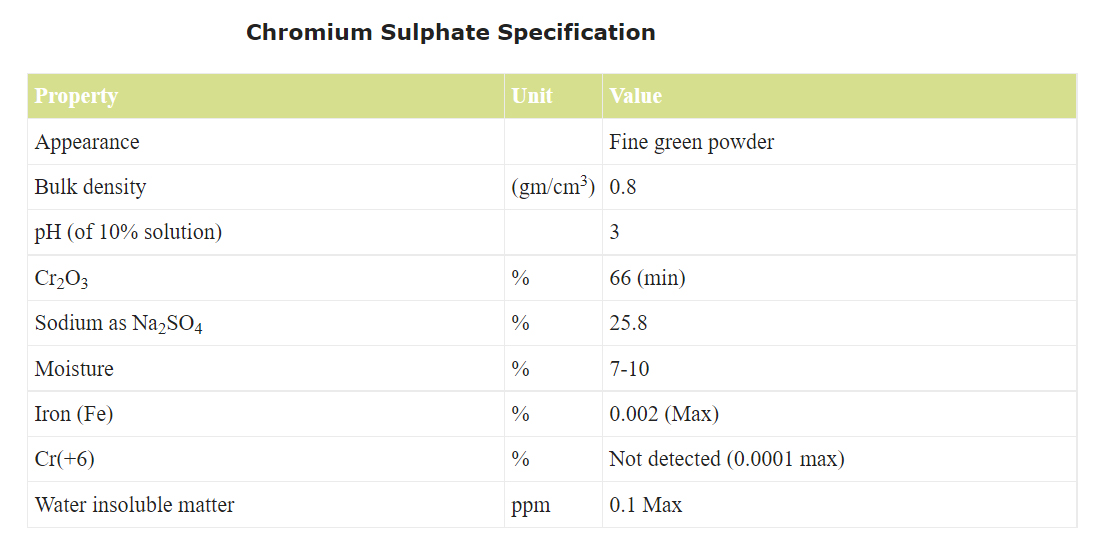
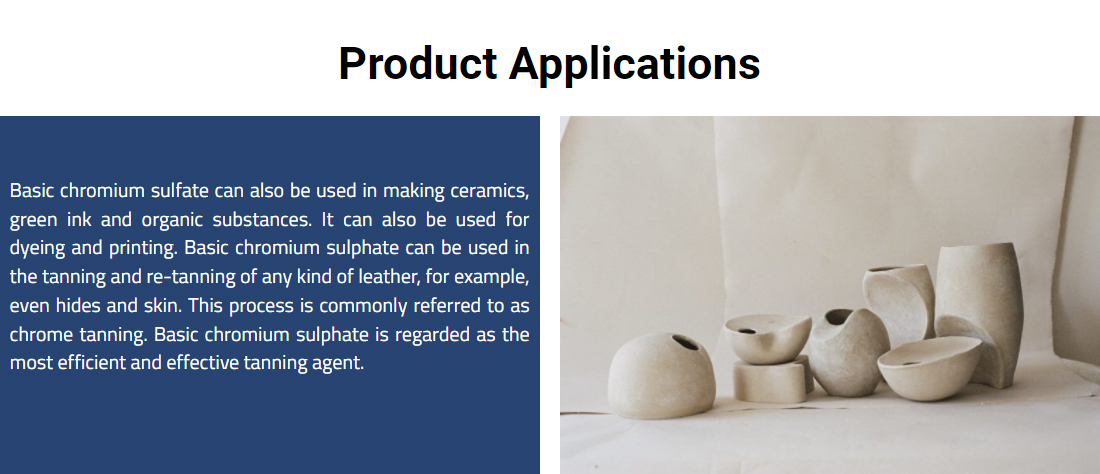
Tanning Industry
Abundant quantity of chromium (III) sulphateis used as a tanning agent in the leather industry. In the tanning process the tanning agent alters the structure of animal protein, which is present in animal hides and skin. Chromium sulphate penetrates itself in collagen fibres at increased pH and undergoes olation and oxolation processes to give polychromium compounds. Chromium has an excellent ability to form stable bridge bonds. Tanning increase spacing between the protein chains and the space is filled with polychrome species.
Metal plating
Chromium sulphate (specially modified) can be used for chromium metal plating in the automobile industry and to manufacture decorative plating utensils. It provides corrosion resistance and surface hardness. Trivalent chrome plating is an alternative to hexavalent chrome plating. Chromium sulphate is the main ingredient of trivalent chrome plating and applicable for decorative coating.
Advantages of chromium sulphate plating over hexavalent chrome plating
• From a health standpoint hexavalent chromium is more toxic than the trivalent chromium sulphate
• Chromium sulphate coating gives higher cathode efficiency.
• Higher cathode efficiency leads to better throwing powder which gives very even and smooth plating in the corners and the surface.
• In trivalent plating anodes do not decompose. Shielded graphite or composites are used with the oxidation preventing additives such as sulphuric acid, which prevents the oxidation of chromium.
Dyeing and printing
Chromium sulphateis used to produce dyestuffs and colouring pigments. It can be used as a mordant dye in textile dyeing which can be directly formed on the fiber. Mordant are compounds with coordination complexes. It is applicable to make insoluble compounds or chrome salts which are used to form pigments used in paint and ink. Usually dichromates such as potassium and sodium dichromatesare used for dyestuff, but chromium (III) compounds are much less toxic than chromium (IV) and (VI) compounds.
Other applications
It is used in the preparation of ceramic glazes. It is used for production of Green ink, making protein and other organic substances insoluble. In dyeing, it is applicable to produce reactive black dye. It is used in chromium industry to obtain chrome alloys when it is specially modified for metal industry application. It is used in automotive parts finishing. It is also used as a coating auxiliary agent.
Quebracho Extract
From Argentinean quebracho wood, vegetable extracts and furfural for tanning and several industrial applications
Production takes place at its manufacturing plants based at La Escondida and La Verde, located in the province of Chaco (North East of Argentina), an area rich in quebracho forests.
Tradition, innovation, state of the art facilities and staff with proven experience in the sector make Indunor a well-established and highly respected company.
Environmental protection is one Indunor’s main goals and the preservation of the Chaco forests guarantees the continuation of its commercial activities. Indunor collaborates with the Argentinean local authorities who directly control the clearing activities and the supply of wood to the Silvateam plants.
Quebracho’s tannin production (around 25,000 tons per year) is integrated with the furfural and furfuryl alcohol production (5,000 tons per year). The residues are used in a biomass power station of 6MW capacity, allowing Indunor to be self-sufficient in energy.

Thanks to Indunor, quebracho extract has become a universal quality symbol for shoe leather, bags, and other real leather products. It is a highly recognized product by Italian and French fashion brands. Indunor is also the official sponsor of the Genuine Italian Vegetable Tanned Leather Consortium, an association of companies operating in the Tuscan tanning area.
Quebracho extracts are also used in many industrial applications such as oil drilling, mineral flotation, ceramic and sanitary items. It is an additive for cement and asphalt and for the manufacturing of inks, varnishes, and lacquers.
The company also produces synthetic tannins and furan resins made from vegetable extracts.
Recently, and in order to explore new markets, Indunor has successfully penetrated the animal nutrition sector by developing innovative blends of vegetable extracts which improve the health and productivity of farm animals.
Indunor also produces tannic acids for oenological use.
Color / Appearance
Heartwood color typically a light to medium reddish brown, sometimes with darker blackish streaks. Color darkens upon prolonged exposure to light. Pale yellow sapwood distinct from heartwood, though transition is gradual.
Grain / Texture
Quebracho has a fine, uniform texture with a high natural luster. Grain tends to be irregular, roey, and interlocked.
Endgrain
Diffuse-porous; medium to large pores in no specific arrangement, few to moderately numerous; primarily in radial multiples of 2-3; tyloses and other heartwood deposits present; narrow rays not visible without lens, normal spacing; parenchyma vasicentric and unilateral.
Rot Resistance
Quebracho is rated as very durable, and is also resistant to insect attacks. Quebracho also has excellent weathering characteristics.
Workability
Difficult to work on account of its density and irregular grain. High cutting resistance, as well as pronounced blunting effect on cutters. Dries slowly—and tends to crack, check, and warp while drying. Turns and finishes well, and also able to take on a high natural polish without any finishing agents.
Odor
There is no characteristic odor associated with this wood species, though it is reported to have a bitter taste.
Allergies / Toxicity
Although severe reactions are quite uncommon, Quebrachohas been reported to cause respiratory irritation, as well as nausea. See the articles Wood Allergies and Toxicity and Wood Dust Safety for more information.
Pricing / Availability
Very seldom available in the United States, Quebracho is somewhat elusive as an imported hardwood. Expect prices to be in the medium to high range for an exotic wood.
Sustainability
Quebracho is not listed in the CITES Appendices, and the IUCN reports that Schinopsis quebracho-colorado and S. balansae are species of least concern, though S. haenkeana is on the Red List as vulnerable due to a population reduction of over 20% in the past three generations, caused by a decline in its natural range, and exploitation.
Dipentene 93%
Dipentene (also called D-Limonene), is a terpene liquid found in various volatile oils such as cardamon, mace, nutmeg , turpentine oil. Dipentene is mainly composed of Limonene, beta-Phellandrene, Myrcene and other terpenes.
- Used as a solvent for resins, alkyds and waxes and to make paints, enamels, lacquers and polishes
- Used as a perfumery composition for soaps, personal care products and cosmetics
- Used as an intermediate for terpene resins, carvone, terylene, and rubber chemicals. It is used as an oils dispersant, metal dryer
- Used as a substitute for chlorinated solvents in degreasing metals for cleaning in the electronic industry
- Used as starting material for the synthesis of terpene resin. alpha-Limonene
- Used as a gallstone solubilizer in pharmaceutical industry
- A special pleasant aroma
- A cyclic Terpene
- disolve anhydrous ethanol, ether, chloroform and other organic solvents and insoluble in water
- Containers which are opened must be carefully resealed and kept upright to prevent leakage
- Keep container tightly closed in a dry and well-ventilated place
- Store in cool place
Product Name |
Dipentene |
CAS |
138-86-3 |
MF |
C10H16 |
MW |
136.23 |
EINECS |
205-341-0 |
Mol File |
138-86-3.mol |
Melting Point |
-84--104 °C |
Boiling Point |
176-177 °C(lit.) |
Density |
0.844 g/mL at 25 °C(lit.) |
Vapor Density |
4.7 (vs air) |
Vapor Pressure |
<3 mm Hg ( 14.4 °C) |
Refractive Index |
n20/D 1.473(lit.) |
Fp |
119 °F |
Storage Temp. |
2-8°C |
Form |
Liquid |
Color |
Clear colorless to pale yellow |
Odor |
Pleasant, pine-like; lemon-like |
Odor Threshold |
0.038ppm |
Explosive Limit |
0.7-6.1%, 150°F |
Water Solubility |
<1 g/100mL |
Merck |
14,5493 |
BRN |
3587825 |
Stability |
Stable. Flammable. Incompatible with strong oxidizing agents |
InChIKey |
AJSJXSBFZDIRIS-UHFFFAOYSA-N |
CAS DataBase Reference |
138-86-3(CAS DataBase Reference) |
NIST Chemistry Reference |
Limonene(138-86-3) |
EPA Substance Registry System |
Limonene (138-86-3) |
Hazard Codes |
Xi,N |
Risk Statements |
10-38-43-50/53 |
Safety Statements |
24-37-60-61 |
RIDADR |
UN 2052 3/PG 3 |
WGK Germany |
2 |
RTECS |
OS8350000 |
F |
8-10-23 |
Autoignition Temperature |
458 °F |
TSCA |
Yes |
Hazard Class |
3 |
Packing Group |
III |
HS Code |
0.29021990 |
Hazardous Substances Data |
138-86-3(Hazardous Substances Data) |
Toxicity |
LD50 orally in Rabbit: 5300 mg/kg |
Titanium Dioxide
Titanium dioxide is a kinds of fine white powder that provides bright white pigments. Titanium dioxide has been used a whole century in many industrial and consumer products including paints, coatings, adhesives, paper, plastics and rubber, printing inks, coated fabrics and textiles as well as ceramics, floor coverings, roofing materials, cosmetics, toothpaste, soap, water treatment chemicals, pharmaceuticals, food coloring, automotive products, sunscreens and catalysts, etc.
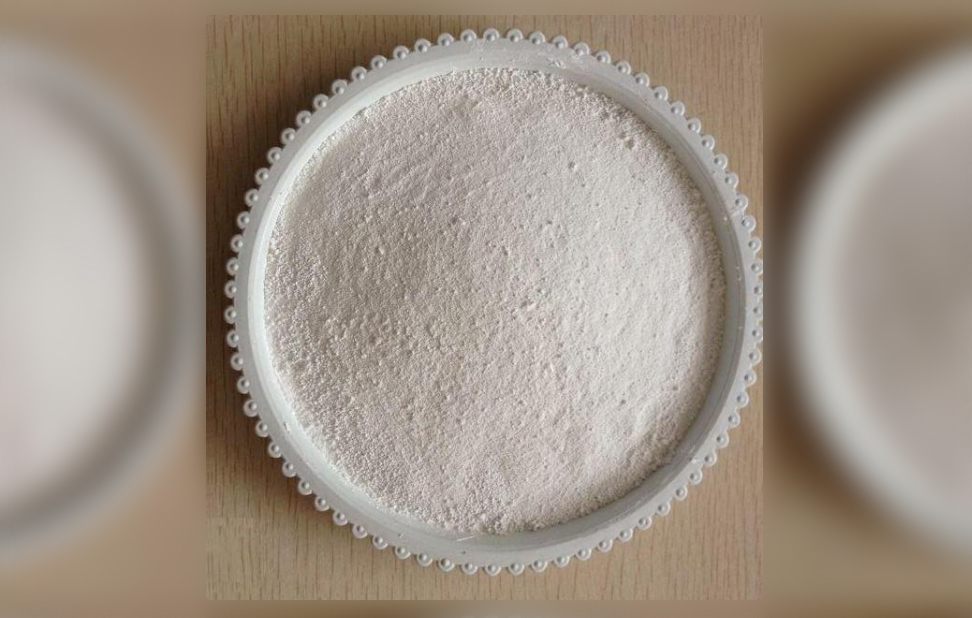
Pure Titanium dioxide is produced into two forms. The main form, which constitutes more than 98% of the total output, is pigment grade titanium dioxide which utilize the excellent light scattering performance of the titanium dioxide in applications that require white opacity and brightness. Another production form of titanium dioxide is ultra-fine (nanomaterials) products. This form can be selected when different properties such as transparency and maximum UV absorption are required.
Ultra-fine grade titanium dioxide is most commonly used for the following specialized applications:
Sunscreen
nano-grade titanium dioxide is transparent to visible light and can be used as an effective ultraviolet absorber. Due to the small particle size, nano-grade titanium dioxide does not reflect visible light, while absorbs ultraviolet light, forming a transparent barrier that protects the skin from harmful rays of the sun. According to the American Skin Cancer Foundation, using titanium dioxide-containing sunscreens can help prevent skin cancer.
Catalyst
nano-grade titanium dioxide can be used as a supporting material for catalyst applications.The main applications include the elimination of hazardous waste gases in the automotive industry and the removal of nitrous oxide from power stations.

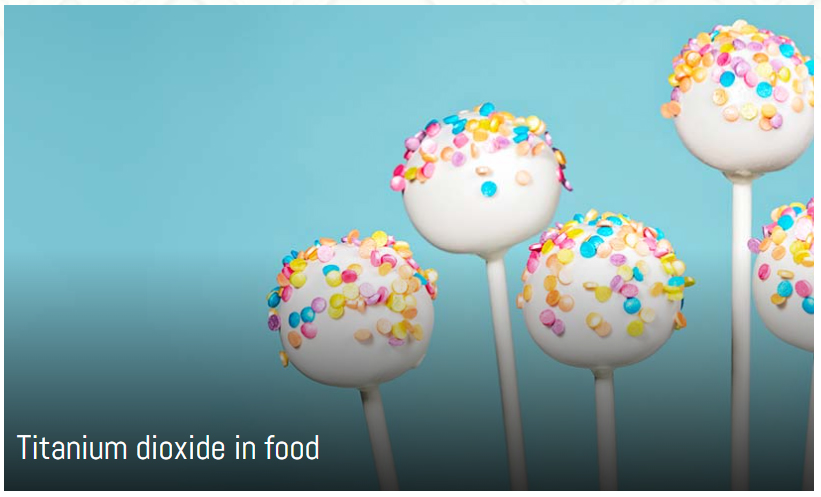


Methylene Chloride
Methylene chloride is highly volatile and nonflammable, and among chlorinated solvents, it demonstrates excellent solubility for fats and oils. Consequently, methylene chloride is used in a broad array of applications as a paint remover, urethane foaming agent, and also as a reaction solvent for producing polycarbonate resin and photographic film. Owing to the above mentioned properties solubility, methylene chloride is also widely used for cleaning metals.
Generic names |
Methylene chloride, dichloromethane |
Methylene chloride, dichloromethane |
CH2Cl2 |
Packing /
shipping method
|
250-kilogram drums and 25-kilogram pail cans; tank lorry |
General applications |
• Reaction solvent for producing polycarbonate resin • Extracting solvent for pharmaceuticals and agricultural chemicals • Paint remover • Material for adhesive agents • Urethane foaming agent |
Sr. No |
Characteristics |
Unit |
Standard Value |
1 |
Appearance |
– |
Colourless Clear
Liquid Free From
Suspended Matter
|
2 |
Odour |
– |
Free From Foreign Odour |
3 |
Specific Gravity |
– |
1.32 |
4 |
Colour (APHA) |
– |
5 Max. |
5 |
Purity |
wt% |
99.98 Min. |
6 |
Water |
ppm wt |
80 Max |
7 |
Acidity as HCl |
ppm |
02 Max |
8 |
Non Volatile Residue |
ppm wt |
5 Max. |
9 |
Colour (APHA) |
– |
5 Max. |
4 |
Free chlorine |
– |
Nil |
10 |
Methylene Chloride |
ppm wt |
50 Max. |
- Colorless and volatile liquid
- Nonflammable
- Methylene chloride has excellent solubility compared to other chlorinated solvents
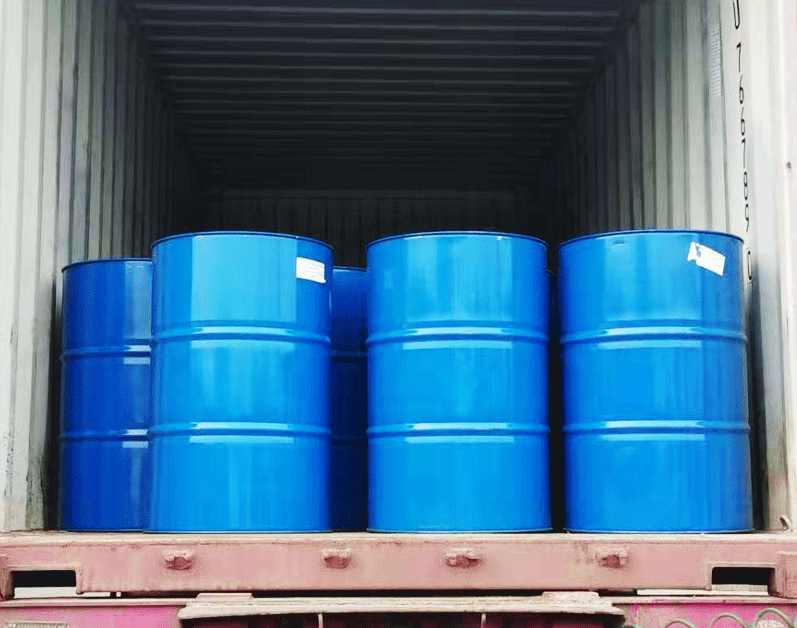
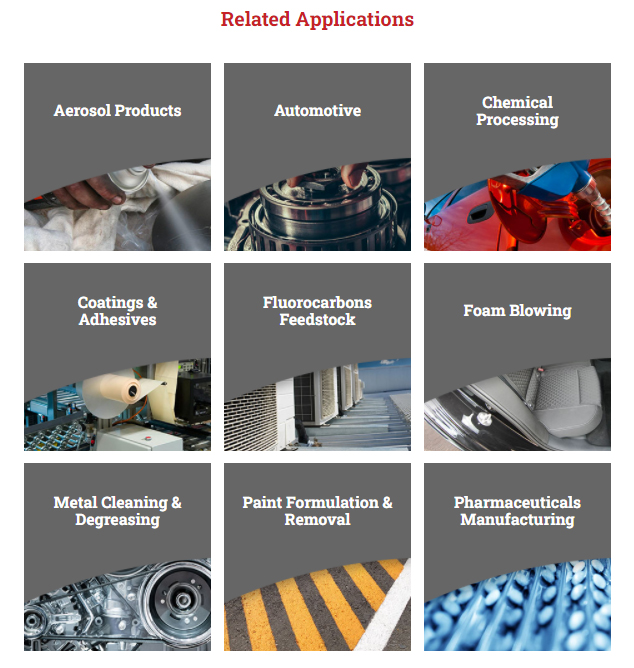
Phthalic Anhydride – PA
Phthalic anhydride (PA) is a white crystalline compound used to manufacture plasticizers, pigments, dyes and resins. One major consumer of PA is the phthalate plasticiser industry, the products of which are used to produce flexible plastic products such as wire & cable applications, hoses, pipes, coated fabrics, roofing membranes and swimming pool liners.
PA is used in the manufacture of unsaturated polyester resins (UPR) that are usually blended with glass fibers to produce fiberglass-reinforced plastics. Principal consumer markets are the construction, marine, and transportation sectors. PA-based alkyd resins are used in paints and lacquers that go in to architectural, machinery, furniture, and fixture applications.
Alkyd & polyester resins for coating application, plasticisers (phthalates) for plastics (PET), synthetic lubricants, agricultural fungicide, medicines & pesticides.
Arpadis is one of the largest chemical distributor in Europe.
Arpadis is handling the storage, transport, export & import formalities of Phthalic Anhydride globally.

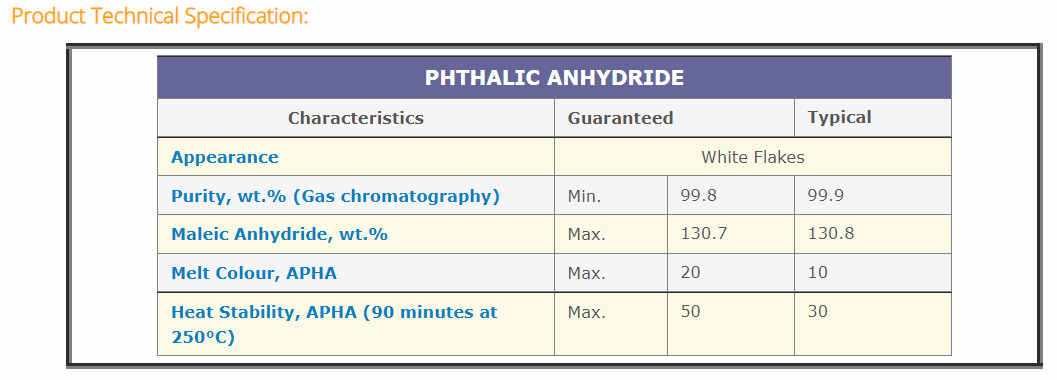
Sodium Tripolyphosphate - STPP - Food & Technical Grade
Lorem Ipsum has been the industry's standard dummy text ever since the 1500s.
Phenol
Lorem Ipsum has been the industry's standard dummy text ever since the 1500s.
Barium Sulphate
Lorem Ipsum has been the industry's standard dummy text ever since the 1500s.
Ferrous Sulphate
Lorem Ipsum has been the industry's standard dummy text ever since the 1500s.
Poly Aluminum chloride
Lorem Ipsum has been the industry's standard dummy text ever since the 1500s.
Decoloring Agent
Lorem Ipsum has been the industry's standard dummy text ever since the 1500s.
Sodium Tripolyphosphate - STPP - Food & Technical Grade
Lorem Ipsum has been the industry's standard dummy text ever since the 1500s.
Aluminum Sulphate
Lorem Ipsum has been the industry's standard dummy text ever since the 1500s.
Sodium Bi Carbonate
Lorem Ipsum has been the industry's standard dummy text ever since the 1500s.
Citric Acid Mono Sodium Glutamate
Lorem Ipsum has been the industry's standard dummy text ever since the 1500s.
L - Lysine HCL
Lorem Ipsum has been the industry's standard dummy text ever since the 1500s.
L - Lysine Sulphate
Lorem Ipsum has been the industry's standard dummy text ever since the 1500s.
L - Lysine Threonine
Lorem Ipsum has been the industry's standard dummy text ever since the 1500s.
Choline Chloride
Lorem Ipsum has been the industry's standard dummy text ever since the 1500s.
Sleather Chemicals
Lorem Ipsum has been the industry's standard dummy text ever since the 1500s.
Gum Rosin
Lorem Ipsum has been the industry's standard dummy text ever since the 1500s.
Alpha Pinene
Lorem Ipsum has been the industry's standard dummy text ever since the 1500s.
Turpentine
Lorem Ipsum has been the industry's standard dummy text ever since the 1500s.
Oleo Pine Resin
Lorem Ipsum has been the industry's standard dummy text ever since the 1500s.
Chloroform
Lorem Ipsum has been the industry's standard dummy text ever since the 1500s.
Soda Ash
Lorem Ipsum has been the industry's standard dummy text ever since the 1500s.
Calcium Oxide
Lorem Ipsum has been the industry's standard dummy text ever since the 1500s.
Antimony Trioxide
Lorem Ipsum has been the industry's standard dummy text ever since the 1500s.
Zinc Oxide
Lorem Ipsum has been the industry's standard dummy text ever since the 1500s.
Alumina
Lorem Ipsum has been the industry's standard dummy text ever since the 1500s.
Sodium Nitrate
Lorem Ipsum has been the industry's standard dummy text ever since the 1500s.
Potassium Hydroxide
Lorem Ipsum has been the industry's standard dummy text ever since the 1500s.
Boric Acid
Lorem Ipsum has been the industry's standard dummy text ever since the 1500s.
Nitric Acid
Lorem Ipsum has been the industry's standard dummy text ever since the 1500s.
SOP 50% POWDER
Lorem Ipsum has been the industry's standard dummy text ever since the 1500s.
Monoammonium Phosphate(MAP)
Lorem Ipsum has been the industry's standard dummy text ever since the 1500s.
Ammonium Sulphate
Lorem Ipsum has been the industry's standard dummy text ever since the 1500s.
Magnesium Sulphate
Lorem Ipsum has been the industry's standard dummy text ever since the 1500s.
Urea
Lorem Ipsum has been the industry's standard dummy text ever since the 1500s.
Di Ammonia phosphate ( DAP)
Lorem Ipsum has been the industry's standard dummy text ever since the 1500s.
Calcium Carbonate
Lorem Ipsum has been the industry's standard dummy text ever since the 1500s.
Titanium Dioxide
Lorem Ipsum has been the industry's standard dummy text ever since the 1500s.
White Spirit
Lorem Ipsum has been the industry's standard dummy text ever since the 1500s.
Zinc Oxide
Lorem Ipsum has been the industry's standard dummy text ever since the 1500s.
Carbon Black
Lorem Ipsum has been the industry's standard dummy text ever since the 1500s.
Sodium Chlorate
Lorem Ipsum has been the industry's standard dummy text ever since the 1500s.
Malamine
Lorem Ipsum has been the industry's standard dummy text ever since the 1500s.
Chloroform
Lorem Ipsum has been the industry's standard dummy text ever since the 1500s.
Pulp and paper industry
Lorem Ipsum has been the industry's standard dummy text ever since the 1500s.
Dioctyl Phthalate
Lorem Ipsum has been the industry's standard dummy text ever since the 1500s.
Poly Vinyl Chloride Resin
Lorem Ipsum has been the industry's standard dummy text ever since the 1500s.
Polyethylene Terephthalate Resin
Lorem Ipsum has been the industry's standard dummy text ever since the 1500s.
Epoxidized Soybean Oil
Lorem Ipsum has been the industry's standard dummy text ever since the 1500s.
Masterbat
Lorem Ipsum has been the industry's standard dummy text ever since the 1500s.
Adipic Acid
Lorem Ipsum has been the industry's standard dummy text ever since the 1500s.
Refined Glycerin
Lorem Ipsum has been the industry's standard dummy text ever since the 1500s.
Stearic Acid
Lorem Ipsum has been the industry's standard dummy text ever since the 1500s.
Hydrogenated Palm Stearin
Lorem Ipsum has been the industry's standard dummy text ever since the 1500s.
Soap Noodles
Lorem Ipsum has been the industry's standard dummy text ever since the 1500s.
Palm Kernel Expeller
Lorem Ipsum has been the industry's standard dummy text ever since the 1500s.
SMP - SKIMMED MILK POWDER
Lorem Ipsum has been the industry's standard dummy text ever since the 1500s.
Sodium Cyanide
Lorem Ipsum has been the industry's standard dummy text ever since the 1500s.
Sodium Metabisulphite
Lorem Ipsum has been the industry's standard dummy text ever since the 1500s.
MEG
Lorem Ipsum has been the industry's standard dummy text ever since the 1500s.
DEG
Lorem Ipsum has been the industry's standard dummy text ever since the 1500s.
TEG
Lorem Ipsum has been the industry's standard dummy text ever since the 1500s.
Calcium Carbonate
Lorem Ipsum has been the industry's standard dummy text ever since the 1500s.


